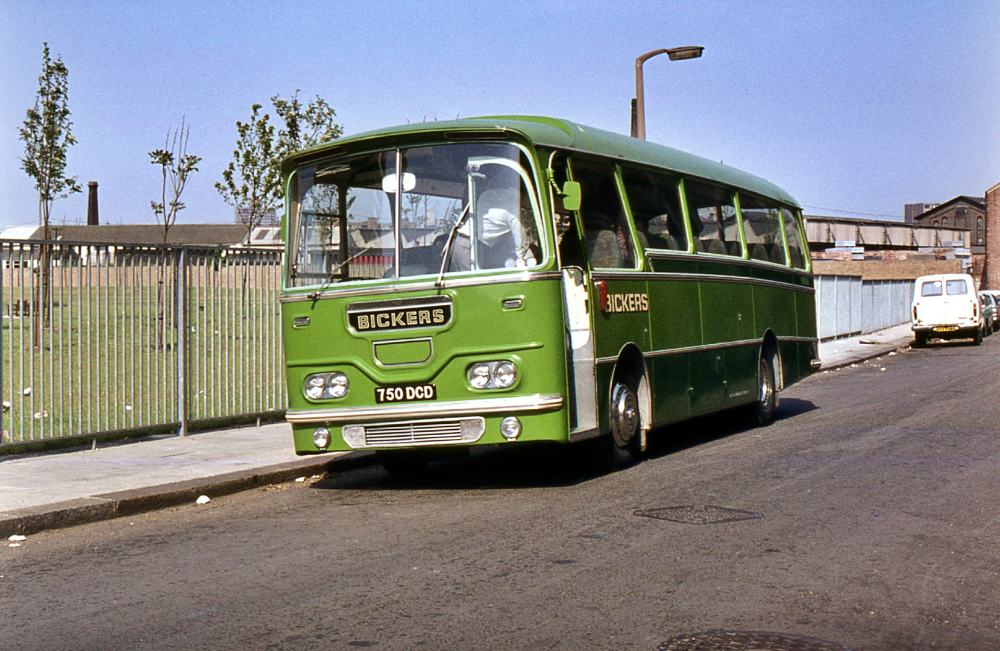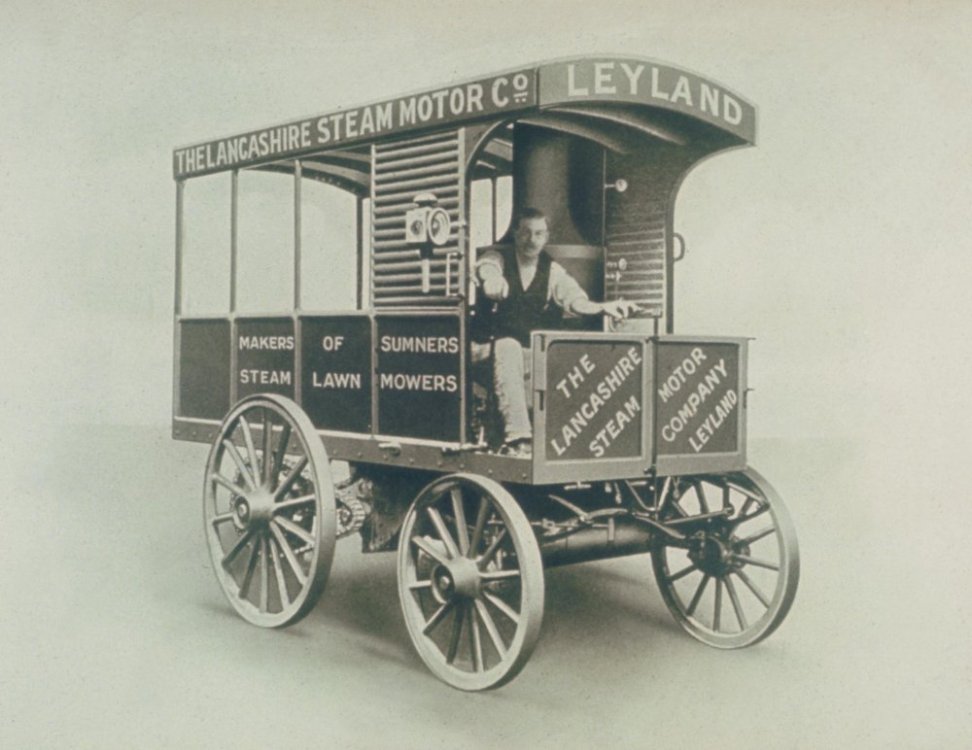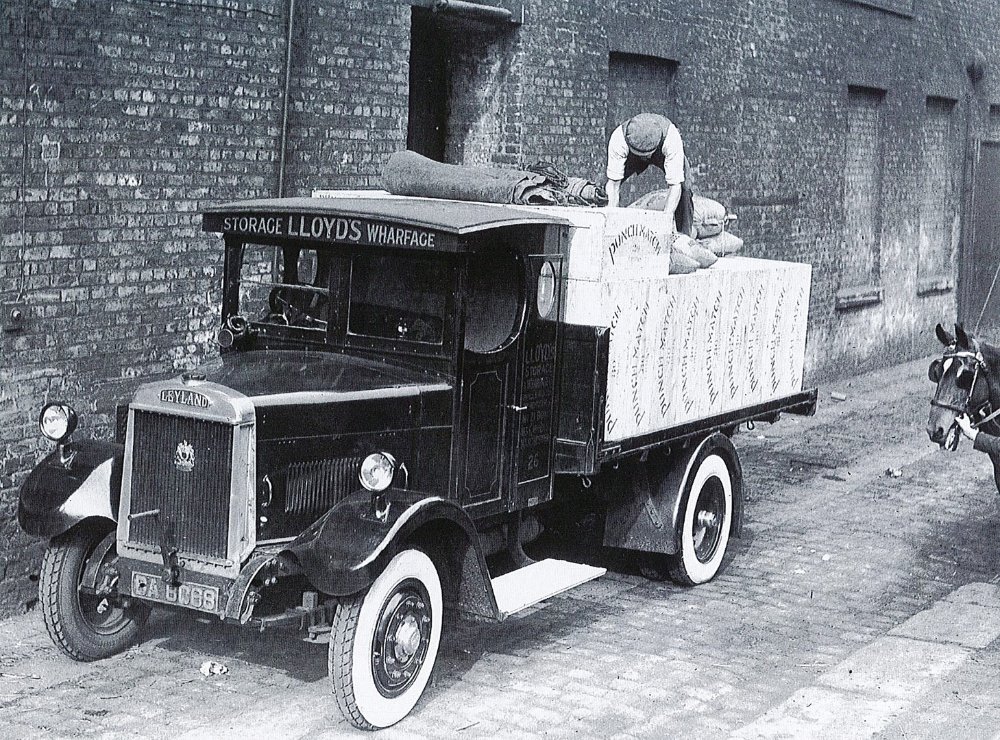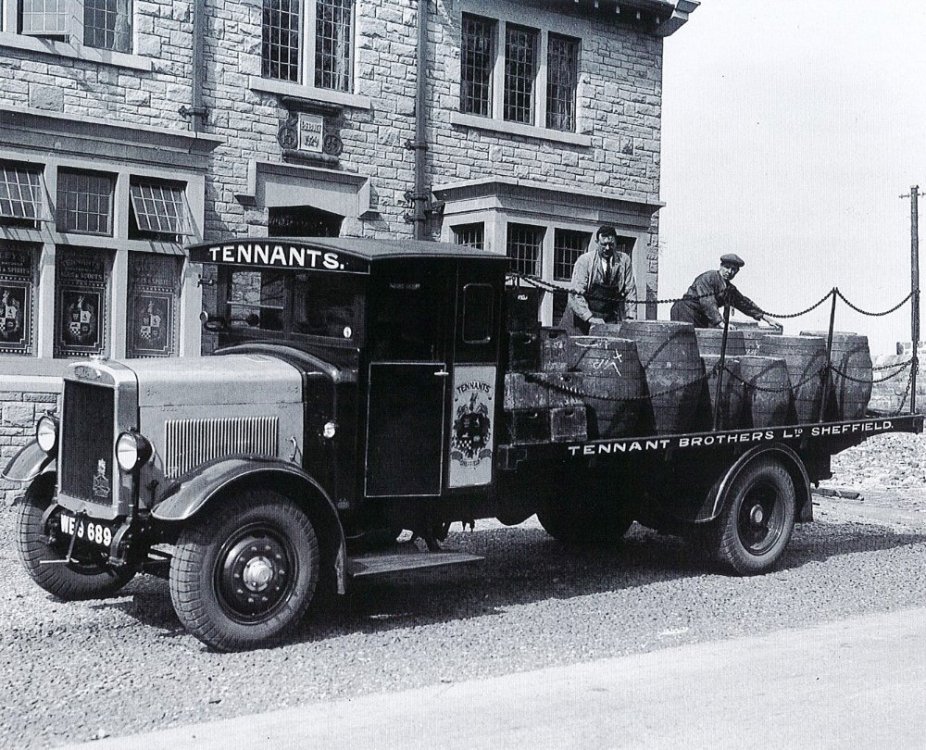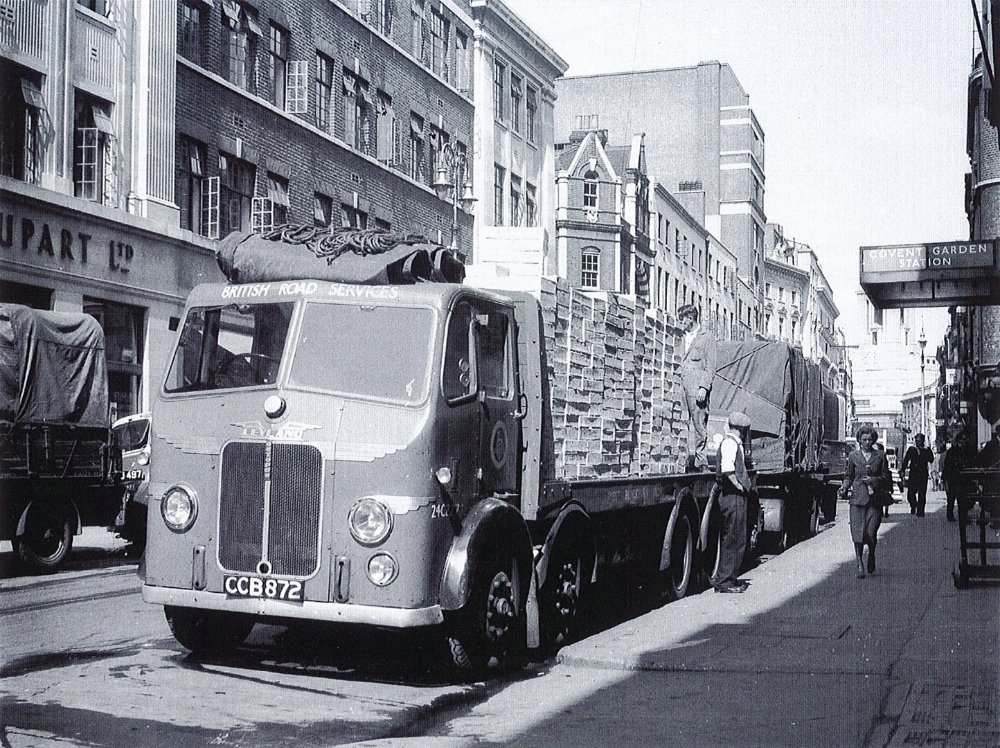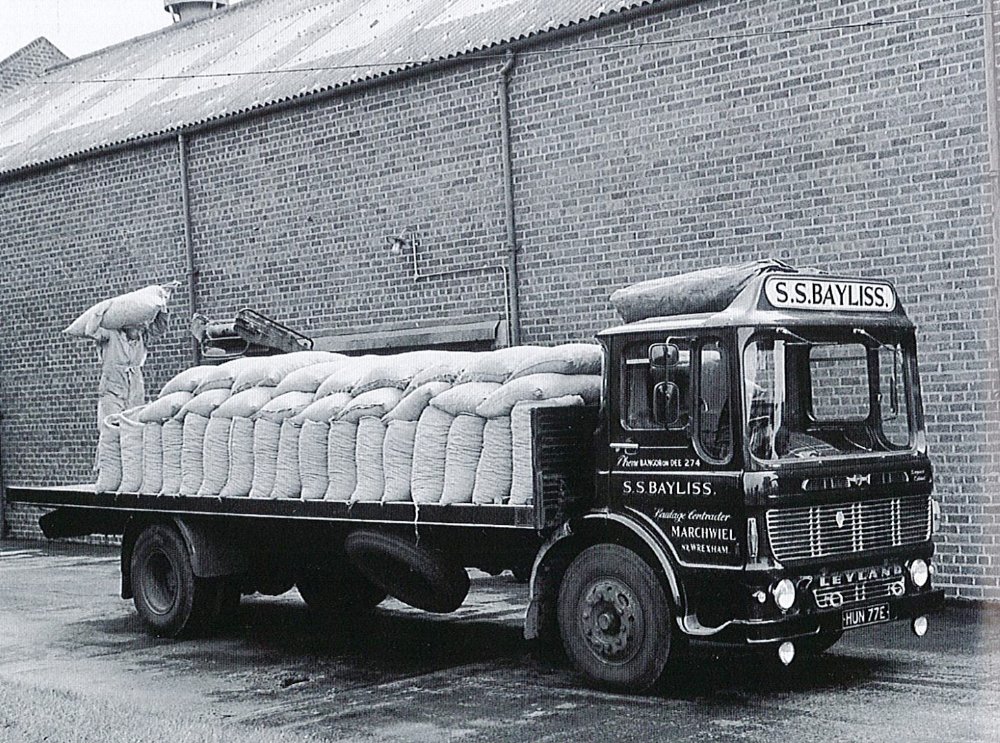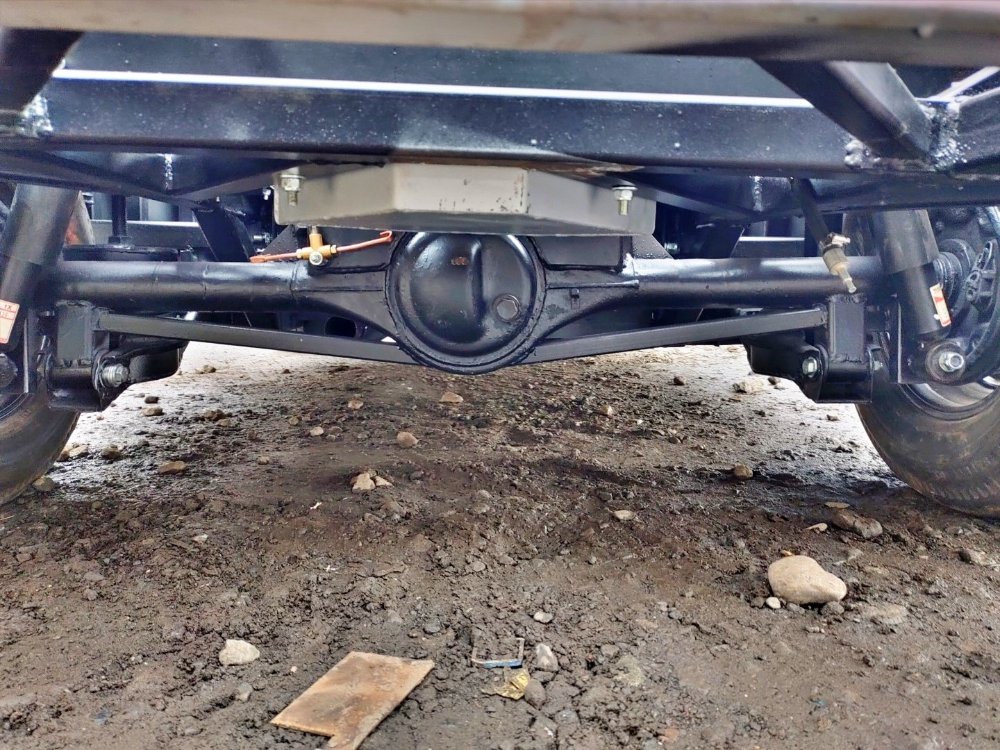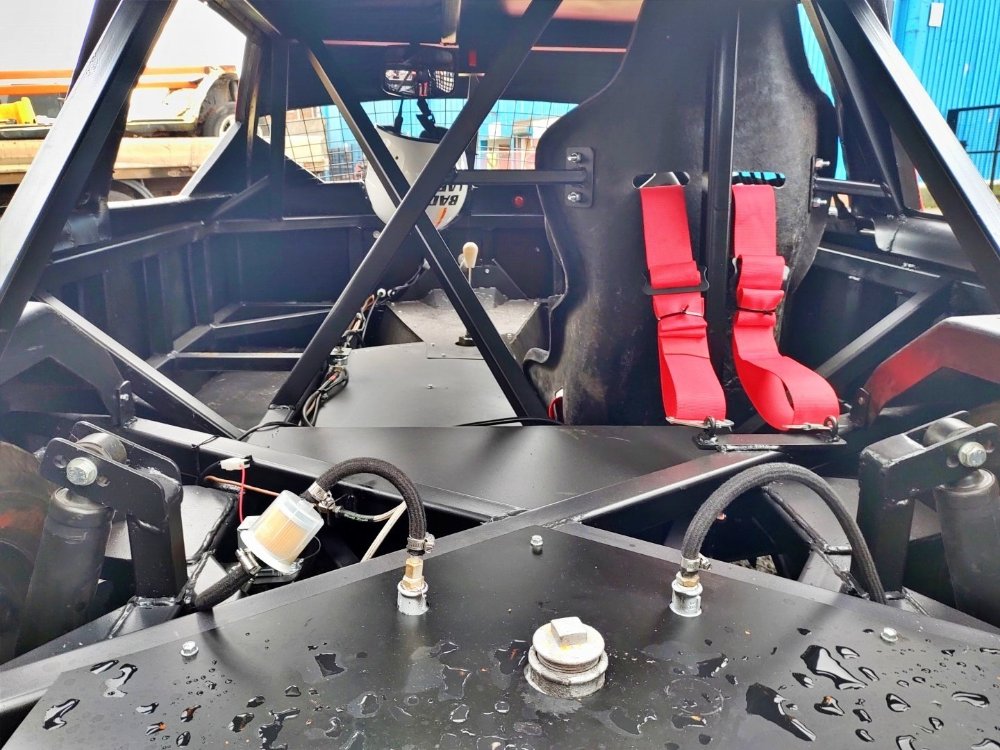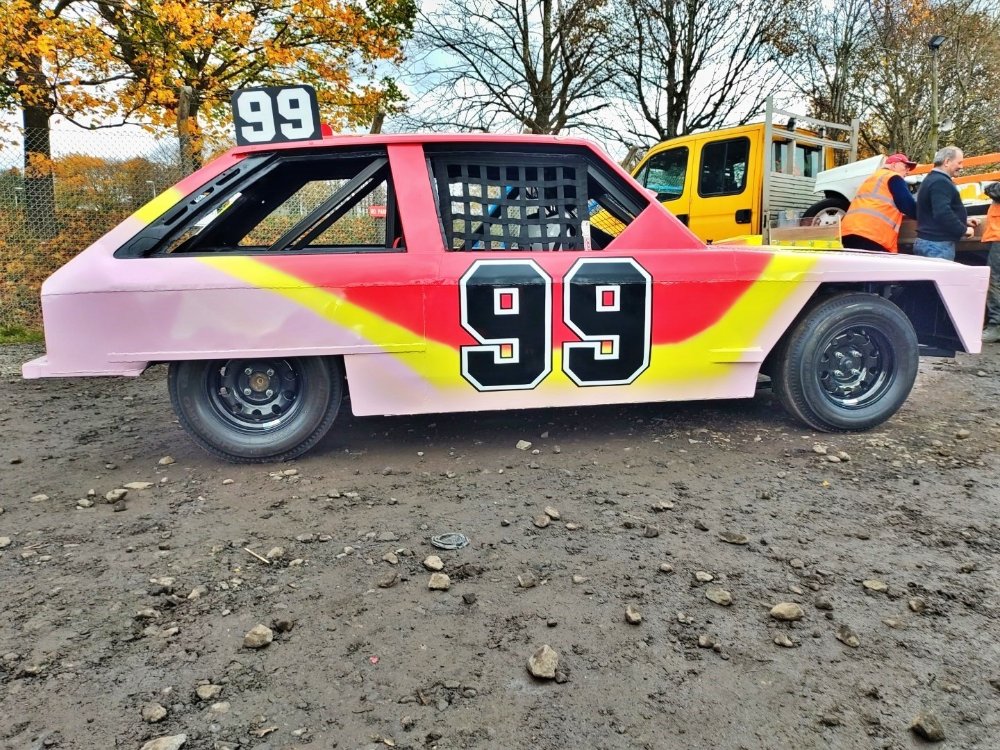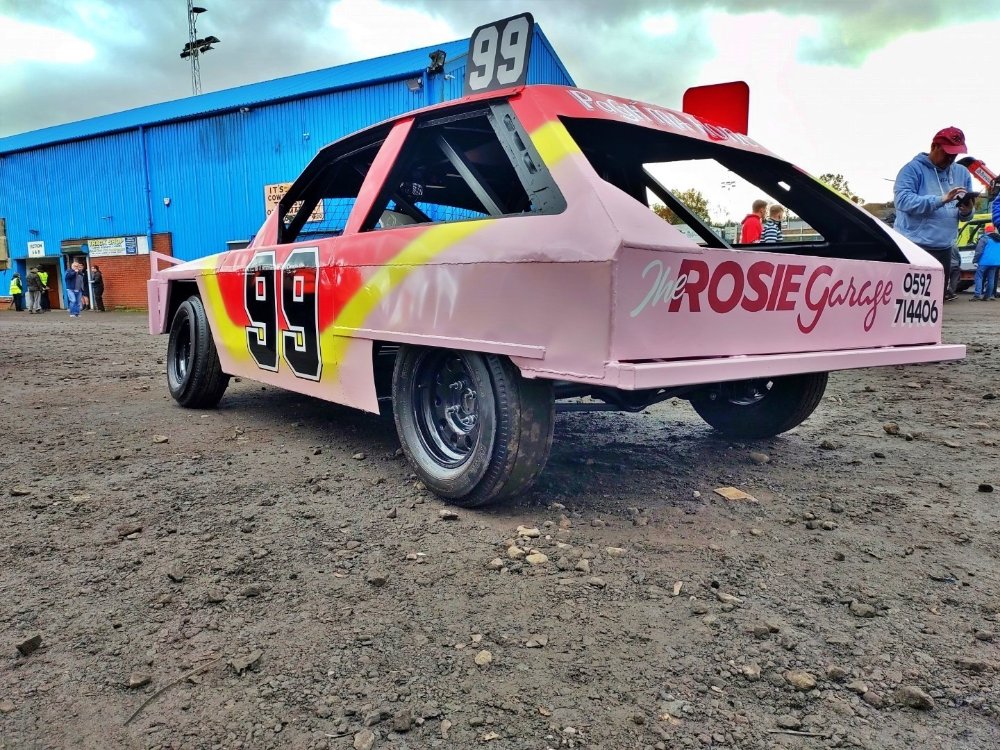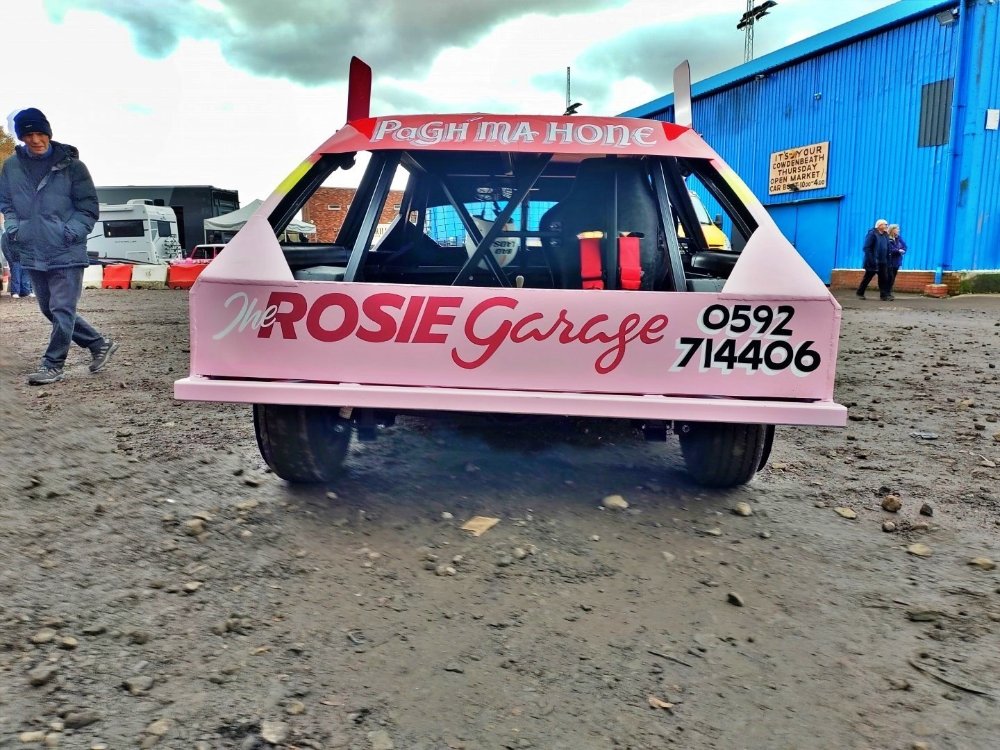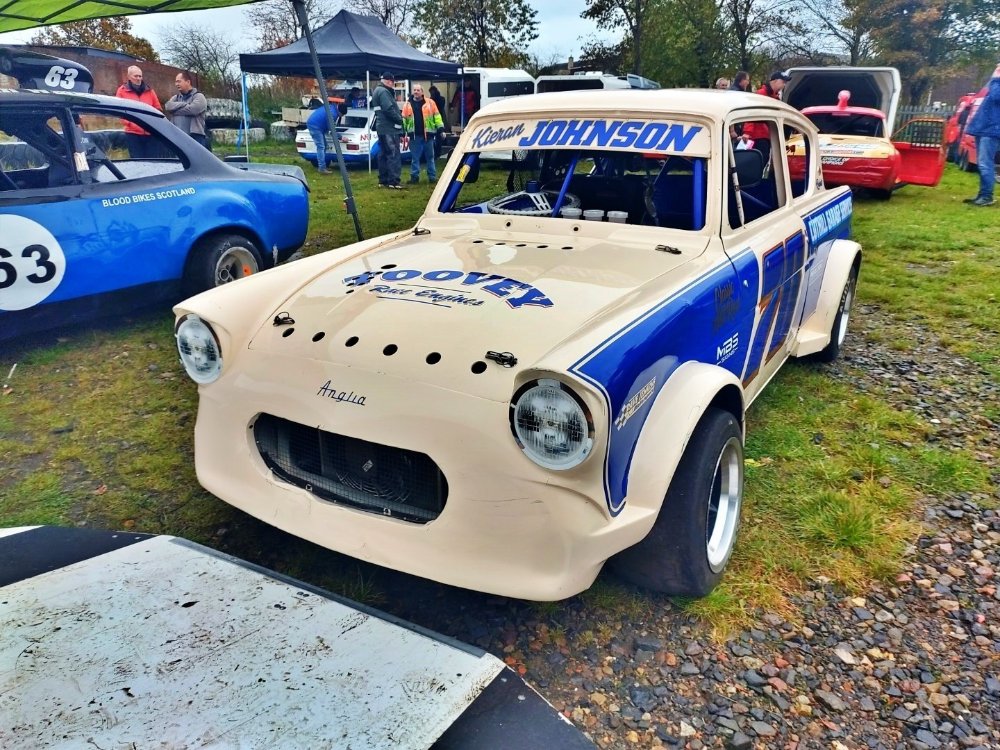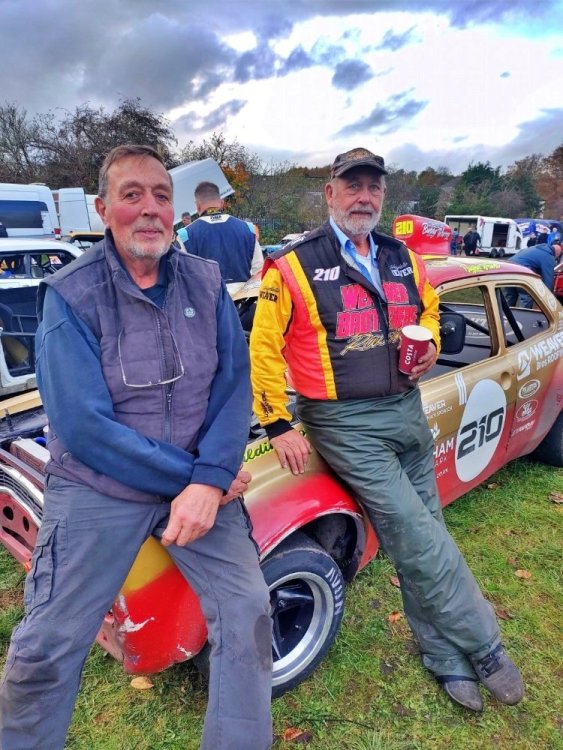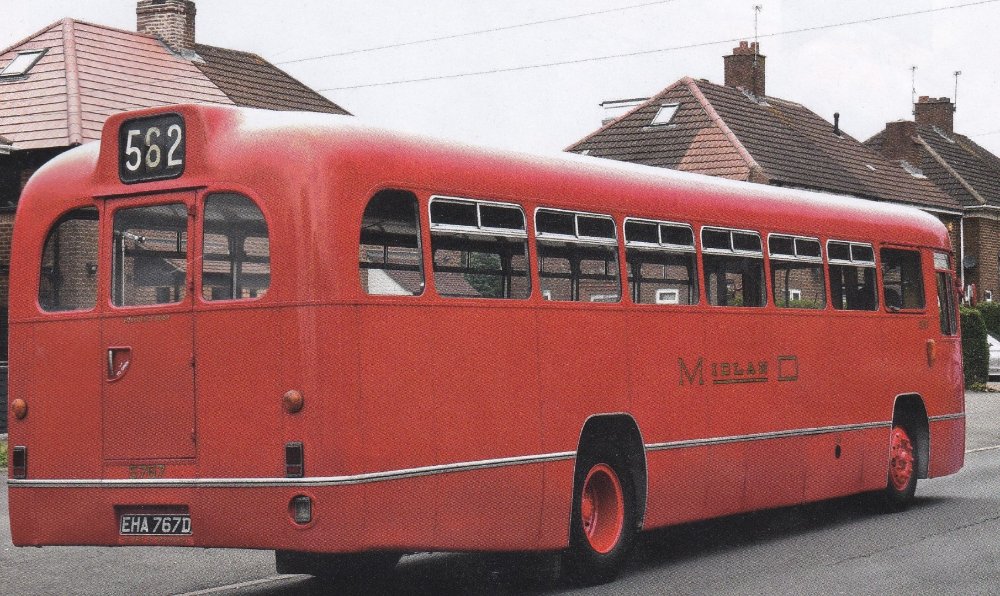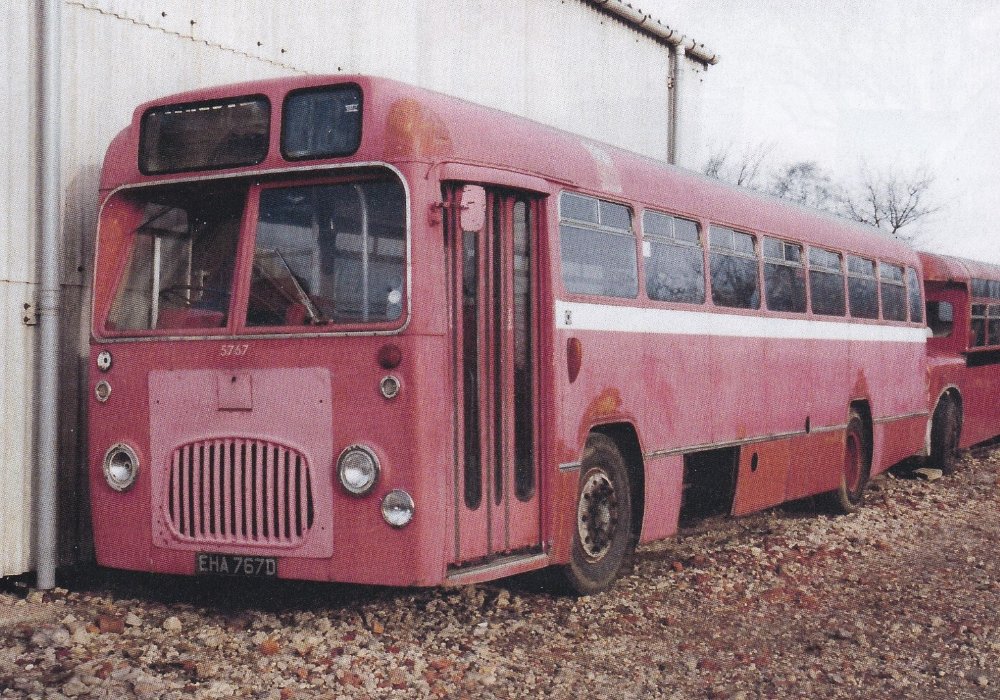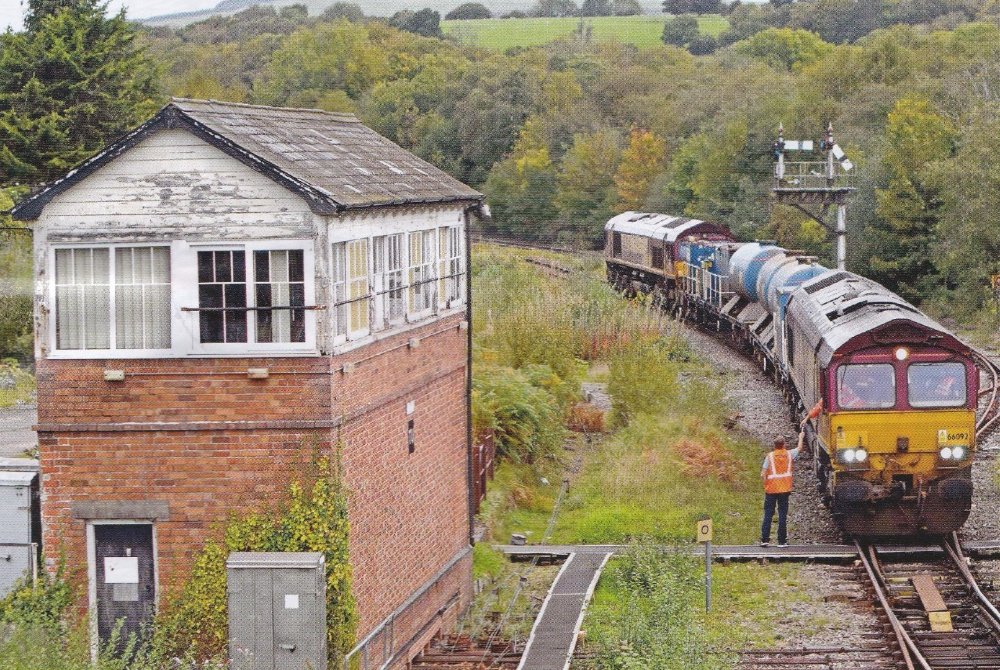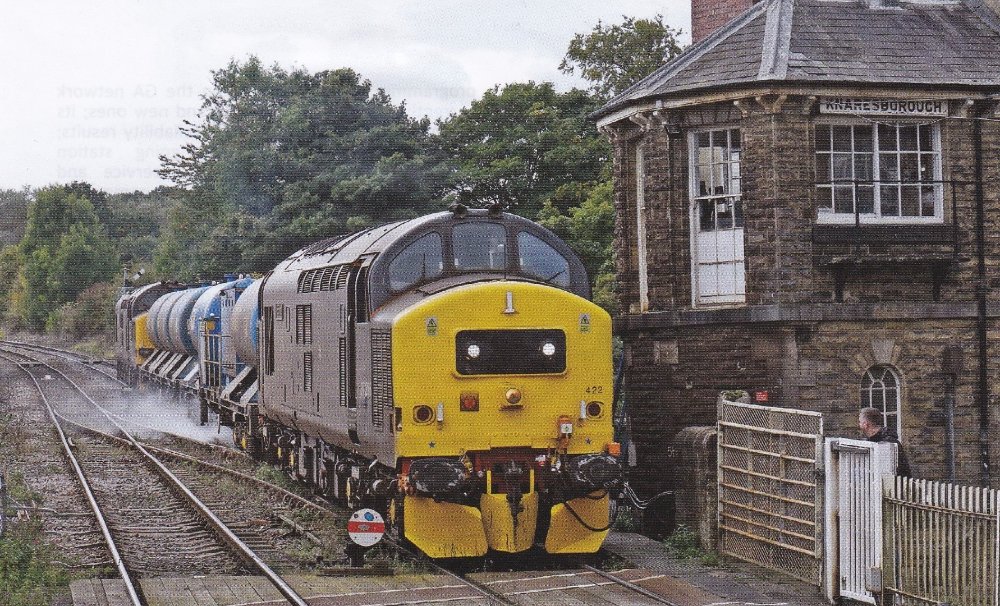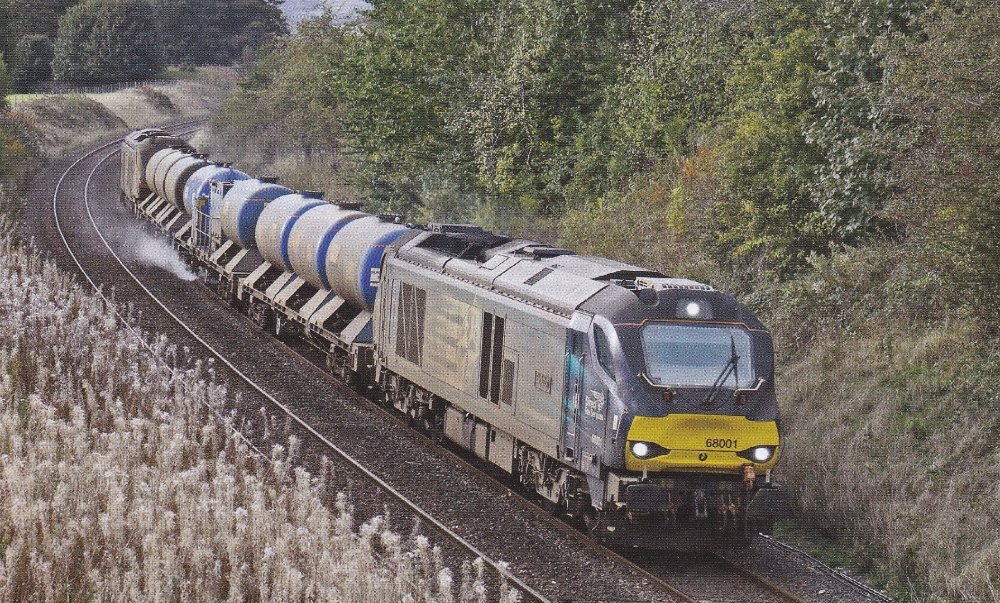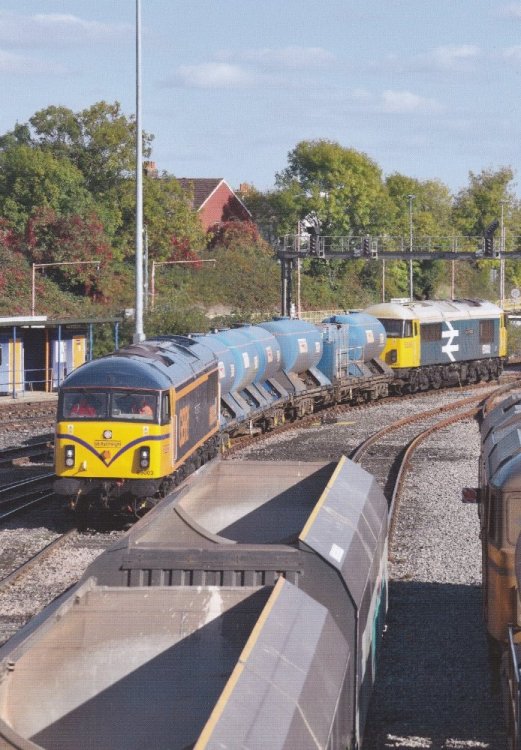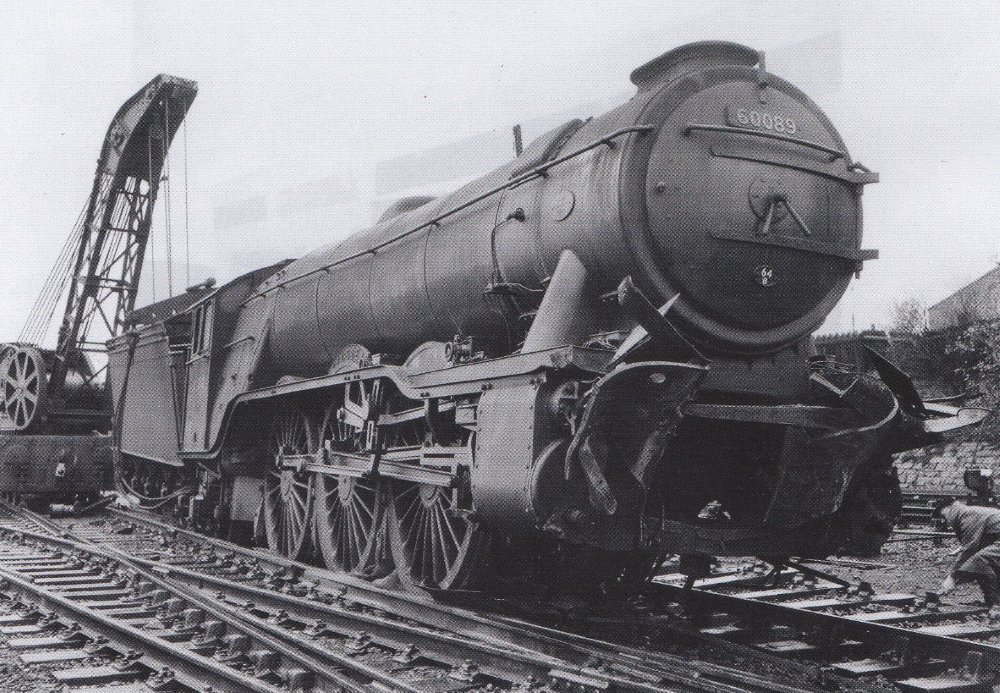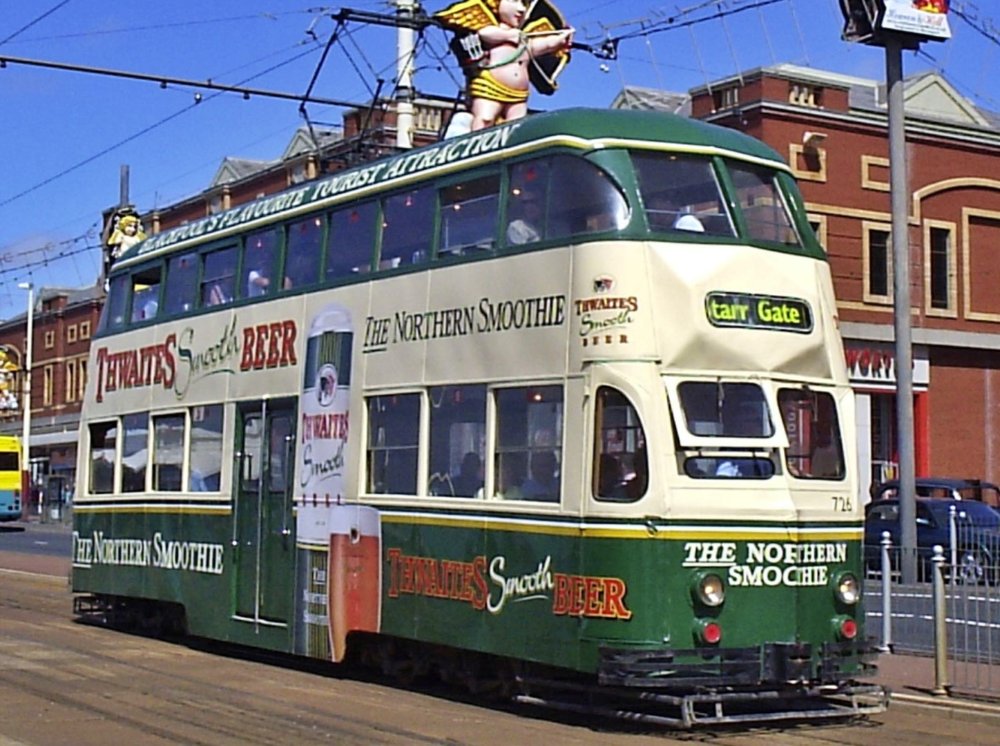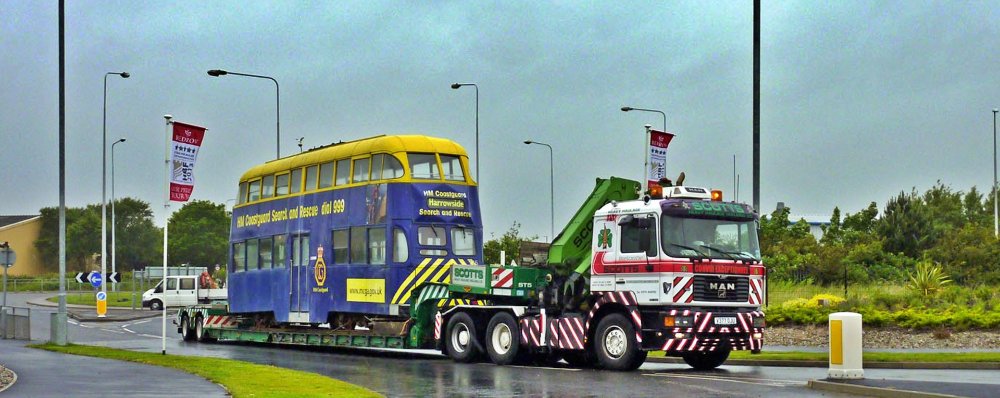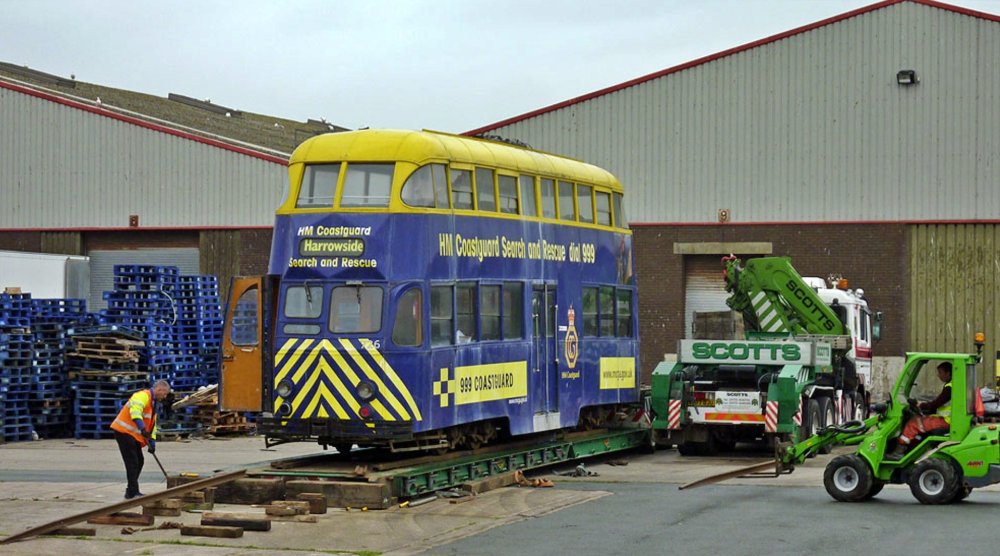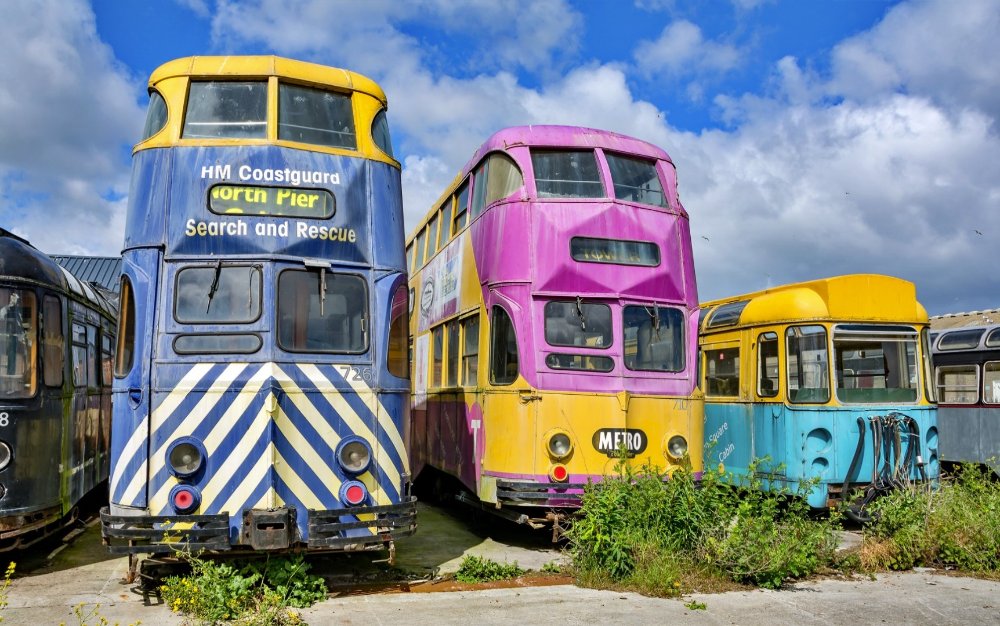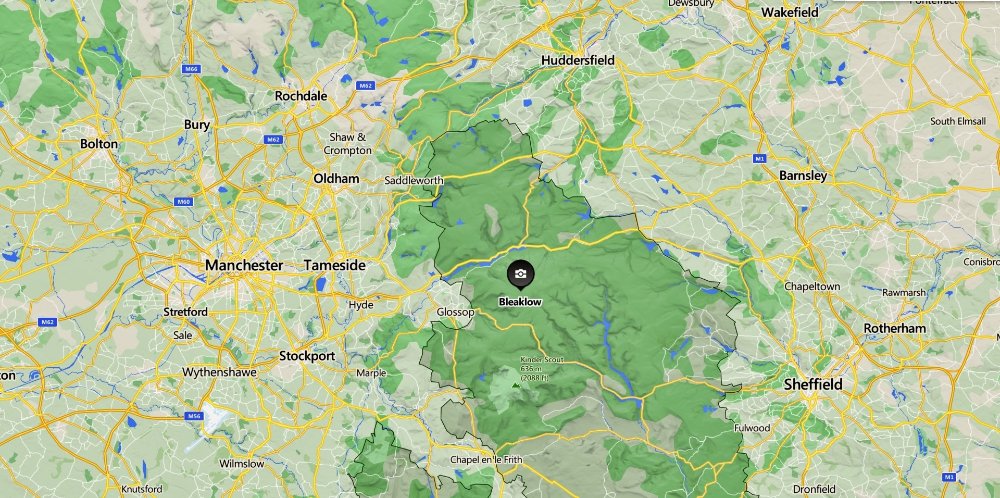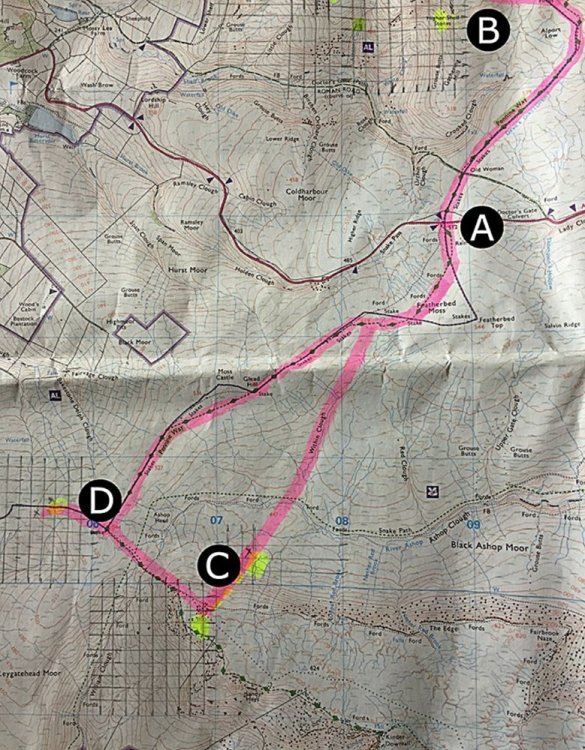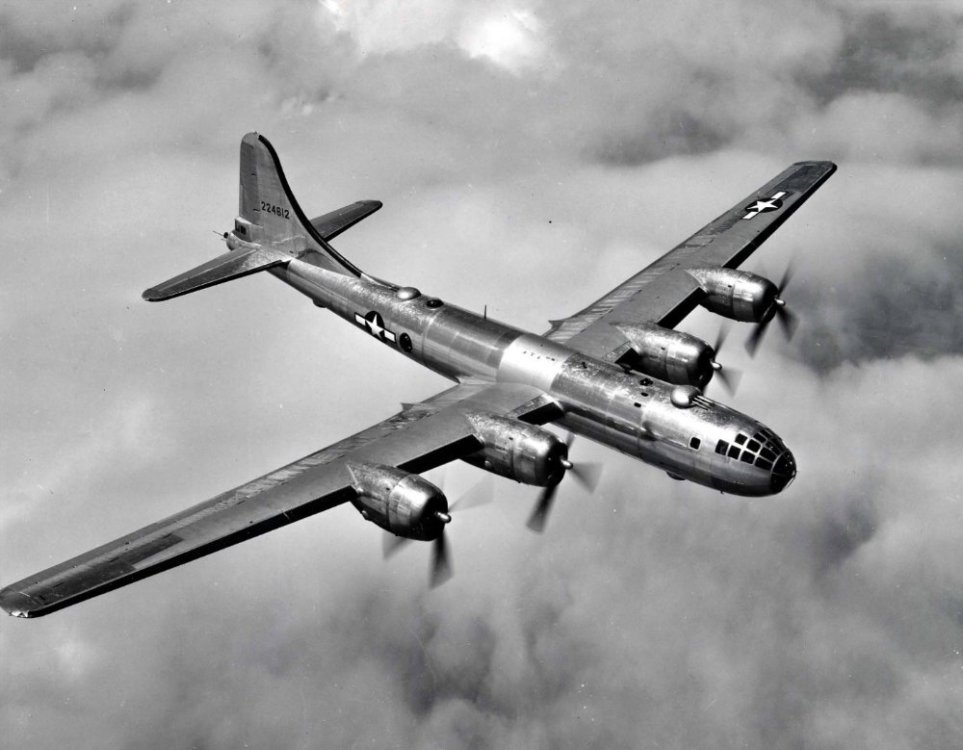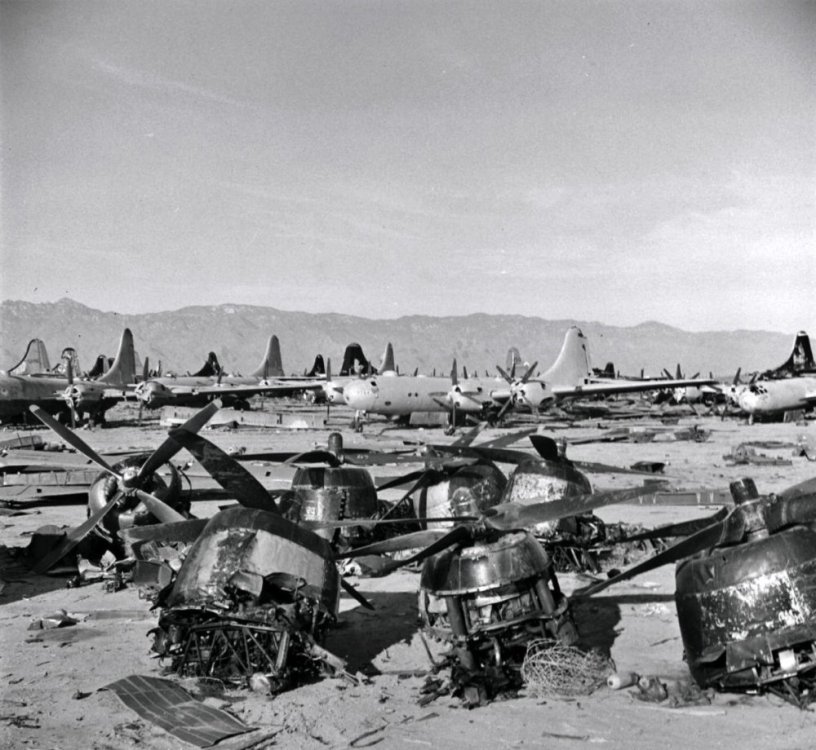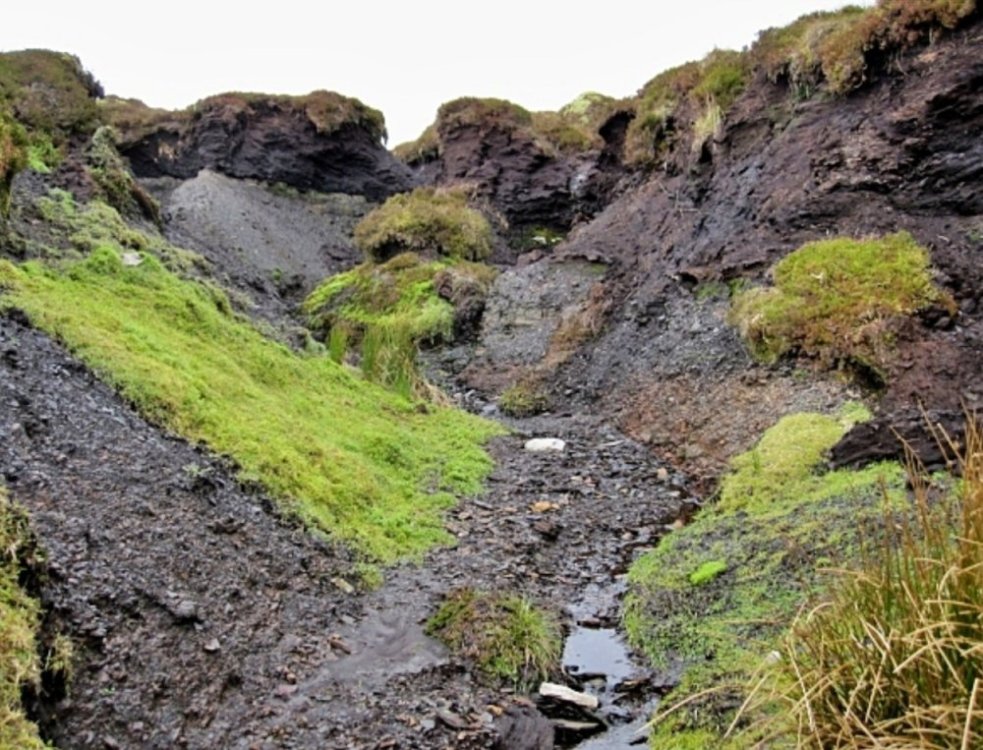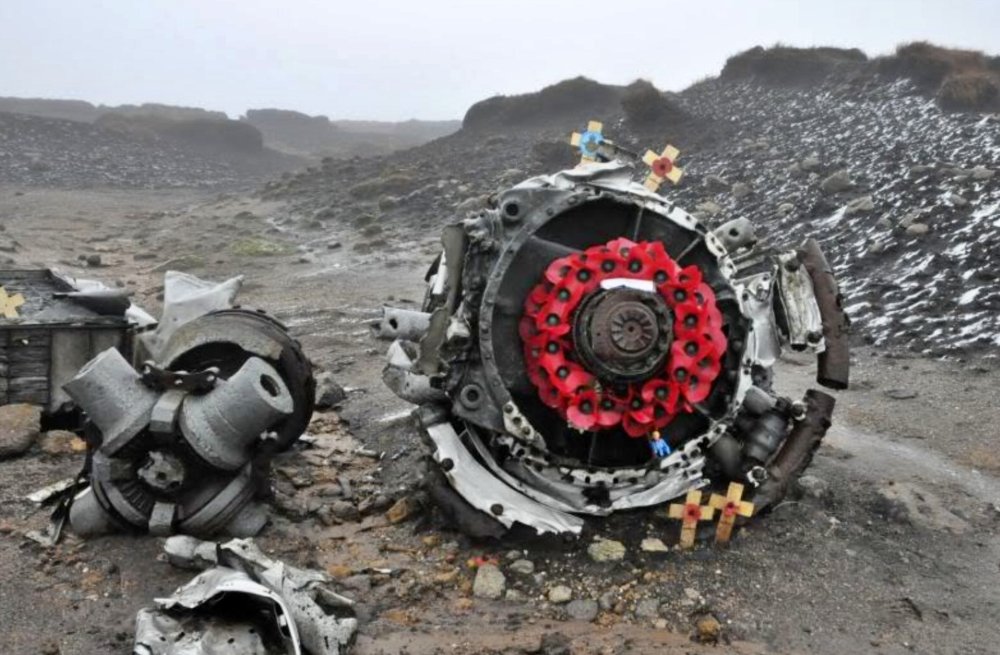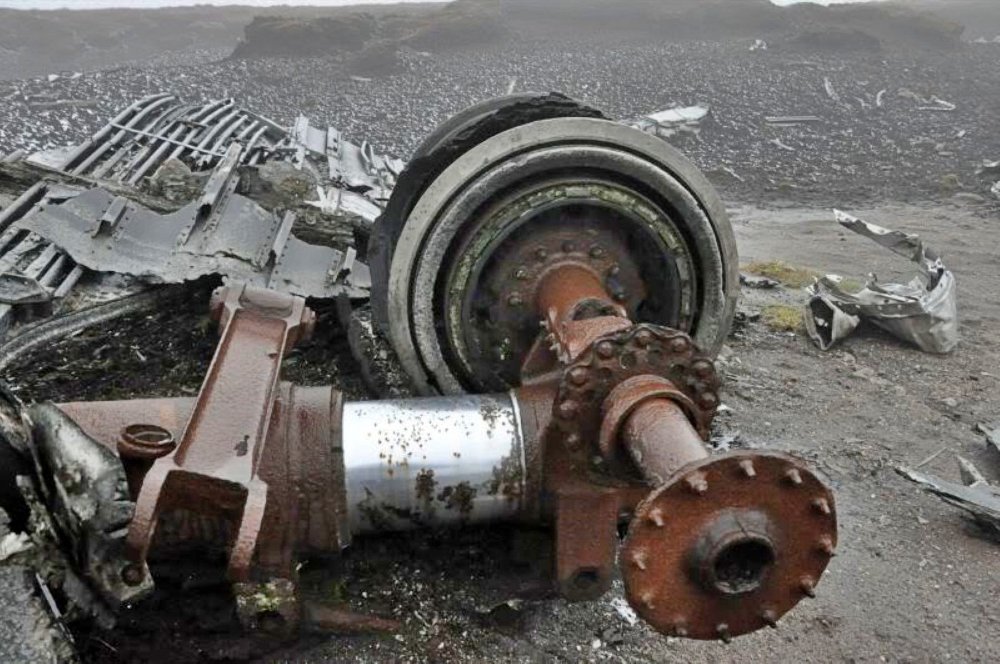-
Joined
-
Last visited
-
Days Won
178
Everything posted by Roy B
-
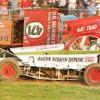
Results - Northampton - Saturday 1st April 2023
Roy B replied to nic's topic in Essential Information
Pit News: 548 - Rebuilding the front left corner. 55 - Clutch repair progressing. 345 - Loaded up with a bent torque rod which caused the prop to disengage from the diff. 138 - Loaded up. In addition to front end damage the gearbox has dropped out! -

Results - Northampton - Saturday 1st April 2023
Roy B replied to nic's topic in Essential Information
Heat Two Happenings: 548 leads away. The 'B' grade scatter in all directions as they go through turn 1. 127 and 545 lock together on the exit of turn 2. 124 spins it turn 1. 548 and 457 collide on the exit of turn 4. 84 threads the needle between 463, 446 and 16 as he powerslides through turns 3 & 4 to take an early lead. Caution for a stranded 138 up against the turn 4 fence with a collapsed front left. 84, 16 and 463 head the restart. 548 gets out of shape along the home straight and clouts the fence virtually head on just past the starter. Caution to remove the stranded car, and to repair the fence. After a lengthy delay the remaining laps are all Tom's as he leathers it around the track in a class display of full sideways through the turns to win by half a lap. -

Results - Northampton - Saturday 1st April 2023
Roy B replied to nic's topic in Essential Information
Pit News: 124 - Front left corner bent back. 55 - Replacing the clutch. 345 - Left kingpin sheared. -

Results - Northampton - Saturday 1st April 2023
Roy B replied to nic's topic in Essential Information
Welcome to Brafield folks. Heat One Happenings: 548 leads away. 545, 326, 124, 127 and 372 all tangle in a heap in turn 1 on the first lap. 84 is through the reds by lap 2 but then goes wide in turn 1 and stalls. 548 and 587 are the top two at halfway. However, 548 spins it in turn 1 next lap. 4 to go 55 bumpers 587 wide to take a short-lived lead as the car suddenly slows and limps around for the remaining laps. The last lap sees 84 collide with a stationary 373 on the exit of turn 4. Sam claims the win. -
Thank you both 👍
-
Pics in the gallery
-
GN Notes: 350 leads away. 212 spat out of the pack through turn 1 on the opening lap. 457 slowed on the back straight. 446 into an early lead. Caution for a stranded 216 on the exit of turn 2. 446, 93 and 166 head the restart. Joe drifts wide in turn 1 but just holds the lead. 166 has closed in and fires 93 in but loses the spot. 55 has caught 515 and they battle through turn 3. Halfway and 446 is still leading. 55 catches 93 on the exit to turn 4 and they collide leaving Craig stationary on the entrance to the straight. A marker tyre straddles the racing line also. Caution period. 446, 217 and 84 head the restart. 217 through to lead. 84 passes 446 in turn 3. 55 and 446 both succumb to flat outside rears in the closing stages. 84 launches a pile-driver of a hit on 217 into turn 3 and takes the lead and sets sail for the victory. That's it folks. Back from Brafield 👍
-
Final Focus: 350 leads away. 335 spins out in turn 3 on the first lap trapping 216. 515 spins unaided on the exit of turn 4. 166 fires 217 into turn 3 but Lee holds the place. 84 is setting a blistering pace and taking no prisoners with liberal use of the front bumper. He moves 217 to the outside of the back straight with a nerf hit. 463 ends up broadside across turn 3 with 166 side on. A number of other cars are involved including 515 who punctures the right rear on the front corner of another car. Caution period. 457 pulls off before the restart which leaves 84 in the top spot at this very early stage of the race. 84, 127 and 217 are the top 3. 127 and 217 then tangle exiting turn 2 which results in Lee hitting an infield tyre and losing places. With the tremendous beasting that Tom was giving the right rear it cried enough and let go before halfway. 55 now took over the top spot and headed to the victory. Behind Craig the remaining cars reeled off the laps in a single file formation all equally spaced.
-
Heat Three Happenings: 548 leads away. 345 hits an infield marker tyre coming to the green which chucks the car broadside up against the concrete blocks. 446 also involved. 45 and 548 tangle on the exit of turn 4 and stop against the fence. Caution for a driver needing attention. All ok after investigation. A complete restart with 548 at the head of the field once again. 515 slows and spends the race circulating at reduced speed around the outside. 45 gets caught up with a group of cars down the back straight and is left facing the wrong way. Nige backs it off the racing line to safety. At halfway 457 has a big lead over 84. The highlight of the remaining laps is a display of superb sideways cornering from both 457 and 84 at opposite ends of the track. Callum's technique very aligned with his car builder's style. With a couple to go 166 puts a big'un in on 127 and 16 entering turn 3 to claim the position. Win number two this season for 457. N.B. 515 - half shaft broke on the first lap.
-
Heat Two Happenings: 548 leads away and gets into a tank slapper down the homestraight resulting in him spinning out in turn 1. 502 into the lead. 55 flying through the field. 45 challenges 502 into turn 3 which allows 55 through. 84 and 217 engage in a multi-lap battle. Tom hits a tyre on the exit of turn 4. The pair continue with a great dice up to halfway. 350 holds 217 up down the back straight which lets the 84 car put a hit in going into turn 3 and move ahead. Next in 84's sights is the Flying Finn who he catches on the back straight but bounces off the 55 rear bumper. Tom elbows his way through in turn 4, but then has a half spin in turn 1. Craig following close behind holds back from spinning him out. 84 eventually takes the victory with a decent gap back to 55.
-
Pit News: 216 - Replacing right rear half shaft. 24 - Front right hub change. 212 - Front panhard rod u/s. Front left shocker damaged by the panhard rod failure. 18 - New wing being fitted. 515 - Propshaft sheared. 55 - A build up of shale in the bottom of the engine bay knocked the belts off.
-
Heat One Happenings: 295 leads away. 457 into the top spot on lap 1. 515 drifts wide and stops against the turn 2 fence. 216 and 268 park up behind him. 18 rolls it on the home straight collecting the metal grandstand emergency evacuation staging just before the starter. All ok. 457 heads the restart. 217 goes by after 3 laps when Callum drifts wide on the exit of turn 2. 55 slows and pulls off. 446 bounces into the turn 1 fence which allows 166 through. At halfway 217 & 457 have a half lap gap to 166. 457 shadows 217 for the remaining laps and tries for a last-bender on Lee but he holds on for the victory.
-
Welcome to Bradford folks. W & Y Race Re-Cap: 350 leads away. 587 slices up the inside of the cars ahead in turn 3. 548 takes the lead from 350 in turn 1 early on. 587 on a charge gets baulked by 350 entering turn 3 and half spins. The close following 24 helps Sam into a full spin with a push on the left rear corner. 24 ends up being fired into the turn 1 fence by 502. 548 still ahead with a fast closing 502 behind. A turn 3 tangle with 67 in turn 3 slows Ricky's progress and allows 548 to break clear for the win.
-

Results - King’s Lynn - Saturday 18th March 2023
Roy B replied to nic's topic in Essential Information
Pics in the gallery -

Results - King’s Lynn - Saturday 18th March 2023
Roy B replied to nic's topic in Essential Information
GN Notes 45 leads away. Nige tangles with 415 in turn 3 on lap 1. 545 takes the lead but then clashes with 381 down the backstraight a couple of laps later but holds on. 16, 45 and 415 come to grief in a tangle in turn 3. 457 is closing on 545 by halfway and takes the lead soon after. 55 up to 2nd as the boards come out. However, a wayward 381 through turn 2 holds up Craig which sees the positions remain static until race end. Callum crosses the line to take his first win. That's it folks. Back from Bradford 👍 -

Results - King’s Lynn - Saturday 18th March 2023
Roy B replied to nic's topic in Essential Information
Final Focus 548 leads away. 392 takes the top spot on lap 1. 93, 16 and 55 crash out in a tangle in turn 3. All get going again but with a loss of track position. 120 now heads the field. 587 catches and passes Casey for the lead. 457 and 124 lock together and exit the race in turn 2. 55 slows and pulls off. 502 spins out and stops on the outside of turn 2. 138 spins it on the homestraight and pulls on to the infield. 587 has a half lap lead over 120 by halfway. 20 shoves 185 into the fence in turn 1. Caution for 499 who has flames coming from under the bonnet whilst parked on the centre. The restart order is 587, 120 and 463. The next few laps are static with the cars evenly spaced. In the closing laps 120 loses his podium spot with a half spin exiting turn 2. Liam sends him completely around with a hit to the rear corner. The 20 car is rewarded with the 2nd spot at the line. The caution period had helped the 16 car back up the field with Mat finishing in 3rd place. -

Results - King’s Lynn - Saturday 18th March 2023
Roy B replied to nic's topic in Essential Information
Heat Three Happenings In drizzly conditions 548 leads away. 415 goes around in turn 3. 326 leads. 16 up to 3rd on lap 2. 138 comes to a stop against the fence on the exit of turn 2 and then pulls off to the infield. 55 in 2nd as a caution is called for a broadside 295 on the homestraight. 326, 55 and 16 head the restart. On consecutive laps 326 drifts wide in turn 1 and loses places to 55, 16 and 587. 20 gives 463 a hurry up into turn 1 which sees James clatter the fence. Liam puts a move on Sarge into turn 3 for the position. Craig has the length of a straight lead over Mat. With 2 to go smoke appears from the exhausts on the 55 car. Craig backs off and nurses it over the remaining race distance for the victory. 587 puts a hit in on 16 entering turn 3 on the last lap to snatch 2nd. -

Results - King’s Lynn - Saturday 18th March 2023
Roy B replied to nic's topic in Essential Information
Heat Two Happenings 115 leads away. 345 pulls off on lap 1. 502 into the lead. 55 is coming through at a rate of knots from the back. 502 and 545 have broken away up front with a sizeable gap to 457 and 463. 381 and 124 collide with a stationary 115 in turn 3 bringing out the caution. 502 takes off on the restart and opens a gap once again. Second placed 457 spins out in turn 2. 55 gives 463 a whack into turn 1 to take another position. With a lap to halfway he moves 502 aside in turn 1 to take the lead. 381 starts to leave a smoky trail. 138 spins 502 into the turn 1 fence on his way through to 3rd. 55 spins unaided and stalls in turn 2. 16 now leads. 446 now into 2nd gives chase. However, a serious eruption of oil smoke appears but it doesn't slow Joe down as he follows Mat over the line at race end. -

Results - King’s Lynn - Saturday 18th March 2023
Roy B replied to nic's topic in Essential Information
Welcome folks to King's Lynn and the start of the 2023 season Heat One Happenings - W & Y 2022 Final 303 leads the field away. 548 takes the lead into turn 1. 268 makes a three abreast move down the backstraight which sees 545 hit an infield marker tyre. 303 spins in turn 2. 415 now into the lead. Russell slides wide in turn 2 which allows 93 through to the top spot. Turn 2 catches cars out virtually every lap with most half-spinning or sliding wide. 541 pulls off with a flat right rear. 3 to go and it's 120 now in the lead. Caution for a stranded 392 in turn 3. The restart line up is 120, 457 (a lap down), 415 and 502. Green and 2 laps. Ricky blasts by the three cars in front of him to take the lead and pull clear. The last lap sees him half spin and stall in turn 2 which allows 120 through for the win in his new car. -
Section 2 above Section 3: Odds and Ends: The Leyland Society had their annual gathering at the Leyland Trucks Assembly Plant back in August. Here are some of the magnificent vehicles that were on display: A 1948 Titan PD2/1 fitted with a Leyland 0.600 9.8 ltr diesel – Leyland 4-speed manual This Titan was one of a batch of six similar vehicles delivered to Lytham St. Annes in 1948. It was given fleet number 10 and remained in service until 1975 by which time it had covered in excess of 950,000 miles without ever leaving the Fylde area of Lancashire! I get to see this fine vehicle on a weekly basis as the owner has a parking arrangement with Blackpool Transport. We've placed it in the driest building on the Rigby Road bus garage site. Two from the Hunter collection The left one is a 1960 Octopus 24.0/4 – Leyland 0.600 9.8 ltr diesel – Leyland 5-speed manual William Hunter purchased this Octopus from the family of Walter Southworth of Rufford after it had been standing in a barn for many years with fertiliser stored on the flat body. It was one of two vehicles purchased at the same time, this one has been restored to William Hunter Livery, whilst the other remains in Southworth livery. The right hand vehicle: 1969 Super Comet 16SCT – Leyland 0.401 6.5 ltr diesel – Albion 6-speed manual Restored by William Hunter to his livery and now forms part of the William Hunter Collection. 1984 Roadtrain 17-25 – Rolls Royce Eagle 12.1 ltr diesel – Spicer 10-speed manual This Roadtrain was probably a special order as it has an unusual combination of large sleeper cab, and the lower rated Rolls Royce Eagle engine. It was new to Tom Walkinshaw Racing and pulled the racing car transporter trailer for the Jaguar Sports Car Team to most motor racing circuits across the UK and Europe. It has now been restored in the livery of a traditional Scottish haulier where the owner’s father worked for many years. It is displayed with a Scammell tandem trailer with a load of steel coils from Ravenscraig Steel Works. 1964 Comet 13C/1R – Leyland 0.370 5.6 diesel – Leyland 6-speed manual This was supplied new in September 1964 through Gilbraith Commercials to T.G Witter from Halsall near Ormskirk. It was used to carry potatoes from York to Ormskirk for many years before being retired from service. The current owner purchased the vehicle in July 2019 in poor condition and it has since been subject to a full rebuild. The cab had no floor and required extensive welding to return the strength into the structure. 1929 Badger TA 1 – Leyland E2F 4 cyl petrol – Leyland 4-speed manual This rare vehicle was delivered new to H. Spencer of Birmingham in 1931 but little is known of its operating history. After being withdrawn from service it was stored for many years in a Scottish bus museum where unfortunately many parts were removed. The vehicle then passed to a Scottish farmer from whom the present owner purchased it. A thorough overhaul followed as well as a major refurb of the cab. Remarkably, the timber frame of the cab survived and only needed minimal treatment before new panels were fitted. The vehicle is finished in the livery of Bees Transport of Hinckley. Southdown Motor Services 1750 (750 DCD) is a Leyland Leopard L2 with Harrington bodywork new in 1963 750 DCD with Bickers standing outside Stewarts Lane Railway depot on an Ipswich Transport Society of London area visit on 15th May 1976. This very well-appointed coach was ideally suited for long days spent "shed bashing" and was used by Suffolk-based railway enthusiasts for several trips of this kind during the 1970s. Many were saddened when Suffolk based independent operator Bickers of Coddenham eventually disposed of this fine vehicle. It was to enjoy many years of further service, however, and it's a great joy to know the vehicle has now been preserved. Alongside we have a 1961 Leopard L2 with Harrington bodywork – Leyland 0.600 9.8ltr diesel – Leyland 4-speed manual Ribble Motor Services took delivery of this Leopard in 1961 which was one of a batch of twenty coaches fitted with the optional air suspension. The coach worked initially from Aintree garage and then moved to other Ribble Depots. It was withdrawn in 1972 and sold to North’s scrapyard. It was then sold to Regent of Redditch who operated it until 1974 when it passed to Jackson’s of Chorley. In 1987, it was sold to Maypole, a Lancashire coach operator who intended to preserve it, but those plans were not completed. It was acquired by Ribble Vehicle Preservation Trust member David Prescott in 1988 and restoration was carried out single-handedly over a twenty-one year period. 1962 Badger 14LWB/1R – Leyland 0.600 9.8 ltr diesel – Leyland 5-speed manual At the time this Badger was completed it was normal practice for vehicles to be delivered from the factory painted only in primer. The dealer would then organise to have the vehicle painted in the livery specified by the customer. This vehicle has been restored to replicate the condition it would have left the Leyland factory. Alongside we have a 1937 Beaver TSC8 – Leyland E39 8.6 ltr diesel – Leyland 4-speed manual Delivered new in 1937 this Beaver was put into service by T J Ellis of Hawarden, Chester after which it passed to Shone Transport of Buckley. After some years in service it was purchased by Jarvis Robinson Transport in Bootle who shortened it to tow trailers out of Liverpool Docks. The Beaver worked for this company until 1968 when it was saved for preservation. I love the destination of this 1953 Royal Tiger PSU1/13 – Leyland 0.600 9.8 ltr diesel – Leyland 4-speed manual Wigan Corporation were the customer for this Royal Tiger which was delivered in 1953. It remained in service at Wigan until 1973 when it passed to Philips of Shiptonthorpe, Yorkshire. When withdrawn by that operator the vehicle was left to languish and its condition deteriorated badly. It was rescued for preservation but was left outside for many years so it deteriorated even further. A painstaking restoration has been undertaken since 2014. 1979 Marathon 2 – Cummins NTE290 14 ltr diesel – Fuller 9-speed manual The Marathon was a new model range developed to take advantage of higher permitted gross vehicle weights and to compete with imported vehicles that were taking a larger share of the UK truck market. It used a revised version of the Ergomatic cab and a turbocharged AEC-developed engine. An updated model, the Marathon 2, was introduced in 1977 with improved interior trim and more powerful engines. This example was new to Mason Transport of Shrewsbury, later passing to Salop Haulage. It was purchased by the present owner in 2000 and fitted with the relatively rare long sleeper cab. 1971 Mercury – AEC AV505 8.2 ltr diesel – AEC 6-speed manual The Federation Brewery in Newcastle were the customer for this Mercury which is a typical example of the type of lorry used throughout the British Isles. It was purchased by a gentleman located north of Alnwick who wished to recreate his former ‘Tillside Haulage’ fleet.He also had a 6-wheeler, as well as an artic tractor unit in the same livery. After he passed away the ownership passed to his family who stored it for a number of years. The present owner purchased it after eleven years of storage. 1957 Titan PD2/40 – Leyland 0.600 9.8 ltr diesel – Leyland 4-speed manual This Titan was new to John Fishwick of Leyland in March 1958 and given fleet No.5. It operated with them for twenty years latterly as a driver training bus. It was sold to Rennie of Dunfermline who operated it for a further three years before it moved to another Scottish independent operator for a brief period. It passed into private ownership in South Wales in 1981 where it remained for eleven years before returning to Leyland in a derelict condition. A thorough restoration was carried out under the guidance of the late Bill Ashcroft which was completed in time for the ‘Leyland 100’ celebrations. It is the only surviving example of thirteen PD2s constructed with the exposed radiator, and Weymann low-bridge body combination. 1958 Tiger Cub PSUC1/5 – Leyland 0.350 5.7 ltr diesel – Albion 4-speed manual This Cub was purchased by Rawtenstall Corporation in 1958 and was fitted with an East Lancs single deck bus body. It was unusual as it was built to an overall width of 7ft 6ins instead of the usual 8ft for use on the narrow roads of the Rossendale valley. It gave twenty-one years of service before being withdrawn and was immediately purchased for preservation by three employees. 1981 Leopard PSU3g/4R – Leyland 0.680 11.1 ltr diesel – Leyland 5-speed automatic The Leopard was a popular bus and coach chassis throughout its production, and many were supplied to the UK and export markets. The Scottish Bus group were regular customers for the Leopard and this example is from one of the later batches delivered to this operator. It is fitted with an Alexander Y-Type body constructed at their factory in Falkirk and entered service with Midland Scottish on 1 January 1982 at their Milngavie depot. The vehicle worked initially as a service bus but ended her career as a school bus after having ten different owners! It is now in private ownership and has been restored to the famous blue and cream livery of her original owner W. Alexander & Sons (Midland) Ltd, including the distinctive bluebird logo. ‘Alice’ a 1988 Sherpa – Perkins 2.0 ltr diesel – BMC 5-speed manual The Sherpa was originally developed by the Light Commercial Vehicle Division of British Leyland to replace the J2, J4 and JU250 vans as a rival to the Ford Transit. It was introduced as a panel van, but chassis versions were also made available for bodybuilders. This pick-up version was one of a batch of twenty similar vehicles bought by Devon County Council. It was purchased by the current owners for use as part of their business in 1996. A line up of Leyland Nationals headed by a 1973 1151/1R Leyland built several special versions of the Leyland National to illustrate the potential of the design for non-bus applications, some of which reached production whilst others remained as concept vehicles. One of these vehicles was the National seen here which was built with a higher floor than standard as a demonstrator for an inter-city coach. It was used by Leyland and carried a special livery with ‘Suburban Express’ branding. It was constructed in 1973 for exhibition at the Scottish Motor Show in Glasgow, and the Earls Court Commercial Motor in early 1974 by which time it had been registered RRM 148M. The saloon was carpeted throughout, and forty-six Chapman Mk.4 coach seats trimmed in an orange and brown moquette were fitted, twin luggage pens replacing the usual seats over the front wheel arches. It was used as a demonstrator for many years, returning to the Lillyhall plant in 1977, after which it was sold to West Midlands police for training and personnel duties. It then passed to Suffolk County Council in 1984 who used it as a school bus until 1991 when it was withdrawn. It has had several owners since purchased for preservation in February 1992. A pair of 1981 National 2 NL116AL11/1R’s – Leyland 0.680 11.1 ltr diesel – Leyland 5-speed automatic OFV 620X – Leyland-based operator J. Fishwick & Sons were a regular customer for Leyland buses and this National 2 was the first of two vehicles delivered in January 1981. It is seen here in ‘in service’ condition. OFV 621X – The second of the two delivered in 1981 and the sister vehicle to the above. It was the last Leyland National 2 demonstrator used by Leyland and was leased back from Fishwick as needed. It is presented in ‘as delivered’ condition. 1984 Tiger TRBTLXCT/2RP – Gardner 6HLXCT 10.5 ltr diesel – Leyland 5-speed semi-automatic This Leyland Tiger was the first of this model to be built with a Gardner 6HLXCT engine and Leyland Hydracyclic gearbox. It was fitted with an Alexander (Belfast) N-Type single deck bus body and delivered to Ulsterbus in 1984. It was registered DXI 3370 and given fleet number 370. It was allocated to Coleraine depot on the north coast and spent its entire time in service from this depot. It was often out-stationed at Portrush sub-depot, and also operated for short periods from Ballycastle, Ballymoney and Kilrea depots in the same area. This vehicle was unique in the Ulsterbus fleet as no further vehicles of this type were ordered. It was sold for preservation in 2007 and relocated to England. We finish with this XF 480 FTG to Euro VI E spec On the road with Openfield Bulk Haulage Keighley and Worth Valley Railway Last Friday I managed to get through the snow to have a look around the Locomotive Works at Haworth: A very snowy scene at Ingrow At Oxenhope Two of the home fleet: 85 Taff Vale Class 02 – Built in 1899 at Glasgow. 52044 L & Y Class 25 ‘Ironclad’. The engine has a long list of film and television credits and is probably best known for its appearance in the 1970 feature film ‘The Railway Children’ when, in green livery, it gained the unofficial name of the ‘Green Dragon’. The engine has also featured in BBC’s ‘Born and Bred’, and the remake of ‘The Hound of the Baskervilles’ A steam gala was held last weekend and one of the guests was 45690 LMS 5XP ‘Jubilee’ Class ‘Leander’ pictured here at Keighley Leander is an LMS 4-6-0 Jubilee Class locomotive designed by Sir William Stanier. Leander was built in 1936 at the LMS works at Crewe at the cost of £6,469 as Makers Number 288, Lot Number 121. The locomotive was named after HMS Leander and entered service in March of that year as LMS 5690. Leander was withdrawn by BR in March 1964, having recorded 1,589,826 miles in service. Into the shed at Howarth next: 144011 became the third Class 144 to be preserved when it was officially presented to the Keighley & Worth Valley Railway from owners Porterbrook. The set was in fact already on the railway. This was due to an unusual arrangement during the Covid-19 pandemic, where the majority of the Class 144 sets were being stored on the heritage line after being removed from mainline service earlier than planned due to fallen passenger numbers. The set was a targeted addition to the railway's fleet who wished to showcase a train of the type that operated in the local area from the 1980's-2000's era. One of the first uses for 144011 was moving 144010 in multiple to Ingrow for onward road movement into preservation. Around the same time, the first restoration/investment was made in the set when the railway had new destination blinds produced with Worth Valley destinations amongst some BR favourites! Further use in 2020 was limited due to the Covid-19 pandemic. In March 2021, 144011 was out and about on the line operating driver training runs and competency refreshers. The summer/autumn of 2021 saw 144011 moved into the workshops at Haworth for a repaint into a more heritage colour scheme, which was a secret for the duration of the works. The two vehicles were quickly stripped of handrails and fittings before having the bodysides and roof rubbed down. The roof was then treated to a coat of grey. The repaint was then fully undertaken, the result being that in October 2021 the set became the first Class 144 set in preservation to be restored to a heritage livery: Metro Red. It was unveiled to much acclaim, with many previously sceptical observers responding favourably to seeing the Pacer in its 1990's guise. After more than a year of preparing paperwork and operating systems to allow the use of second generation DMU's on the railway, 144011 finally entered passenger service in August 2022. 144011 continues to operate selected off-peak duties on the line sharing with first generation stock. 41241 was built at Crewe in 1949. It was withdrawn from service at Skipton in 1966 shortly before the depot closed in 1967. In the National Archive is the correspondence covering the moving of the locomotive from Llandudno Junction to Skipton. It clearly states that it was sent to Skipton to work the Worth Valley branch goods train. The branch had closed in 1961 and this was commented upon by an unknown hand at Euston, when sending the memo back to Crewe where the comment was added; “send in any case; will employ at least two men and use some coal”. Astonishingly, the move was made and at least one Keighley & Worth Valley Railway (KWVR) volunteer remembers it passing his school in Keighley as it arrived from Skipton more or less every day, light engine, about noon. On arrival 41241 was parked in the Banana Siding alongside the long-demolished goods shed, where it stayed for about three hours doing absolutely nothing, rather than work the branch goods, had it still been open and operated. 41241 then went back to Skipton about 3.30 p.m. not having achieved anything at all. It did this utterly pointless exercise for at least two years, presumably employing at least two men and burning lots of coal; a remarkable comment on the objectives of a nationalised industry. It went to Haworth in 1967, under its own steam, and was painted in maroon livery in time to work the inaugural train (together with 30072) when the Worth Valley Railway (as it was originally called) was reopened in 1968. The locomotive is perhaps the most typical branch line passenger locomotive on the KWVR and it is appropriate that it should be a regular performer on the passenger trains. For this very reason also, it was the most suitable engine to display the KWVR contribution to the development of British steam railways in the 1975 Shildon Cavalcade, marking the 150th anniversary of the opening of the Stockton & Darlington line. Since then the locomotive has been repainted in its original BR lined black livery. In 1988 the locomotive was withdrawn from service, having become due for its 10-yearly boiler removal and examination. The engine was retired from service again in 2013 at the expiry of its 10 year boiler ticket. The plan was to have the locomotive back in operation in time to take part in the 50th anniversary of the re-opening of the branch, in 2018. The cost of the work required on 41241 was estimated in 2014 to be of the order of £350,000. Much of this work on the boiler was undertaken at the Severn Valley Railway workshop at Bridgnorth. In early December 2017 the boiler passed its hydraulic and steam tests at Bridgnorth. The boiler was lifted back onto the frames at Haworth in January 2018. When it returns to service it is planned to have it in the red livery it carried when it first ran on the KWVR. At the end of March 2018 the locomotive moved under its own steam when it clocked up two miles running up and down the Haworth loop. During its ‘national service’ life, 37 075 was allocated to nine different locations but as some were visited on more than one occasion, the total number of moves was 13. And that nomadic life continued into preservation with Haworth being its fifth location. This engine is another of the preferred types which came out of the 1955 B.R. Modernisation Plan and, as a Class of locomotive, has enjoyed longevity of use throughout the British Railways period and into the current era of privatisation. This Class was designed as a mixed traffic locomotive. They were able to haul freight and, with a top of speed of 90 mph, and having been fitted with steam heat capability, were just as suited to hauling express and local passenger services, also. No. 37 075 was built by English Electric at their Robert Stephenson & Hawthorns plant and completed in 1962 as No. D6775. The locomotive was accepted by British Railways at Doncaster and then went on to be allocated to Thornaby Depot, Teeside. The locomotive gained its TOPS number of 37 075 in February 1974 and ran various freight and passenger trains including an Ipswich to Wembley Park Football Special train on 6th May 1978. The locomotive moved on a frequent basis around the country, being allocated to the following depots in this order: Hull (Dairycotes), Thornaby, March, Healey Mills, Tinsley (Sheffield), Thornaby, Stratford, Motherwell, Stratford, Thornaby, Tinsley and finally Thornaby. The locomotive was first stored (as serviceable) in August 1994 and was officially declared unserviceable in December of that year. Ownership passed to EWS in September 1998 with No. 37 075 being recorded as “a stored mainline locomotive”. Whilst allocated to Tinsley for the first time, the steam heating boiler, used to heat passenger coaches, was removed (November 1984). It is also worth noting that the noses, at each end of the locomotive, no longer match. One end has the original split head-code boxes but the other is of a later type, being completely flat and with no head-code boxes at all. This change is believed to have occurred due to accident damage, although there is no date of this incident. The locomotive was preserved in August 1999 (though only officially withdrawn from mainline service in November 1999) by the Class 37LA Group which saw the locomotive move initially to the Great Central (Nottingham), and later the Great Central Railway at Loughborough in 2000. Reflecting its time in mainline ownership, its nomadic life was to continue when the 5C Locomotive Group bought the locomotive in 2002 and moved it to the Ecclesbourne Valley Railway, before moving it again two years later to the Churnet Valley Railway in 2007. As is evident by its presence on the KWVR, 2012 saw 37 075 purchased by a consortium of KWVR volunteers and moved it to Haworth. The locomotive now sees use on passenger services and, when a larger engine is required, on works trains or other non-passenger duties. 37 075 has also starred on the small screen back in 2013 as part of the BBC drama ‘The Great Train Robbery’ where it had to masquerade as the Class 40 D326. In 2019 the locomotive returned to the national network when it left the KWVR (towed) for a bogie swap with those belonging to Colas Class 37. 37 075 was fitted with high-speed bogies and those on the Colas locomotive normal/lower speed bogies, the lower speed bogies being more suited to the KWVR. Wheelsets This wonderful original spiral staircase is a highlight of the engine shed No. D3336/08266 was completed at Darlington works as 13336 in 1957, it being the last example of the class to be turned out in black. All subsequent engines being turned out in the British Railways standard green. No. 13336 was new to Sheffield Darnall shed for three months before being transferred to London Kings Cross in May 1957, but returned there in 1958 by which time it had been renumbered D3336. During the 1970s once again the engine was renumbered, now to 08 266 under the new TOPS system. In May 1964 the engine was transferred to its penultimate depot, Tinsley (Sheffield), when this opened to traffic, where it would remain until August 1981. After No. 08 226 was withdrawn on 17th March 1985, it was sent to Swindon from where the KWVR rescued it from the scrap-line at the end of that year. The engine has found useful work, predominantly shunting the heavy steam locomotives around Haworth Yard and occasionally undertaking works-train duties. On rare occasion (usually special events) it has been seen hauling passenger services on the line. These are usually shuttle services between Keighley and lngrow, or full line trips after the last scheduled train has finished. Its use on passenger services is very limited due to its low maximum speed of 15mph. By 2015, now 68 years old, having worked hard on the KWVR, 08 226 was showing its age and an assessment showed that extensive work would be required. With a plentiful supply of replacement locomotives still on the national network, the decision was made to replace the engine with one being retired by EWS. 08 226 remains in the KWVR fleet alongside its newer 08 companion. In 2016, with the arrival of 08 993, and the paintwork showing years of hard work on the Railway, the opportunity was taken to repaint the now reprieved engine into two-tone grey livery. D0226 During the 1950’s the rail industry as a whole started to look more seriously at dieselisation as the future form of motive power and most independent manufacturers realised that, for their long-term security, a success in this field would be most advantageous. English Electric (who were a conglomerate of various builders including Vulcan Foundry) made several prototypes for British Railways to test and evaluate them. Several of these designs ended up being developed and put into production for everyday service including the famed ‘Deltics’. No. D0226 was one of two prototype engines built to the same design with one having electric transmission and the other having hydraulic transmission (No. D0227). The design was made for shunting and transfer work between yards and stations. Both engines were given to British Railways and extensively tested at locations all round England at places like, Liverpool, Doncaster, Stratford (London) and Bristol. They were also tried as banking engines at Gunhouse Incline near Scunthorpe. British Railways had the use of No. D0226 for three years during which it clocked up 38,000 miles. It soon became apparent however, that the designs were flawed. The engines were too powerful for usual shunting duties and not versatile enough for any other useful work. What these two engines did prove to English Electric, though, was that the future lay with electric transmission and not hydraulic. No. D0226 had shown itself to be the more successful of the two types, so, on return to Newton-le-Willows, after the three-year testing period with British Railways, D0227 (the hydraulic version) was scrapped while D0226 was retained by English Electric for occasional shunting duties. The engine was placed on permanent loan to the KWVR by English Electric in 1966 and has been found to be a most useful engine for the line. As the line has a 25mph maximum speed limit, many of the limitations found in British Railways service are eliminated. The 500 hp power rating means it can deal with works-trains at a speed that does not hamper passenger services working in the opposite path. The engine is capable of standing in on passenger services in the event of a steam engine failing in traffic. All in all, this engine has found a niche in preservation which it never found before. In 2014 D0226 had its greatest passenger triumph when it was one of the two diesel locomotives used to haul the downhill leg of the intensive two train operation that brought spectators to the Worth Valley during the Tour de France in July of that year. In 54 years of operation on the KWVR, D0226 has sported many varied and striking liveries but currently sports one that is appropriate to its life on the national network. However, whatever the colour scheme, D0226 is arguable the most reliable and useful engine on the 5 mile branch line. Another guest was 44871 LMS Class 5MT LMS Black 5 4-6-0 No. 44871 was built at Crewe Works in 1945. Originally numbered 4871 by the LMS, she was renumbered 44871 under British Railways after nationalisation. The locomotive was one of the last to be withdrawn from service in 1968, the last year of steam on British Railways. She was also one of four locomotives chosen to take part in the famous Fifteen Guinea Special on the 11th August 1968, but is one of only three from that to survive. Taking on coal 1054 LNWR ‘Coal Tank’ – Built at Crewe in 1888 During the late 19th century, the Chief Mechanical Engineer of the London and North Western Railway, Francis William Webb, designed a 0-6-0 tender engine for hauling freight (predominantly coal traffic) and this became known as the “Coal Engine”. These engines were not, however, really suited to use on other aspects of local or branch line working. By replacing the tender with a set of side tanks for the water, extending the frames of the engine at the rear with an extra set of wheels and adding the bunker for the coal, the so-called ‘Coal Tanks’ were born. The first of these “Coal Tanks” were introduced in 1881 and, over 16 years, the fleet expanded until a total of 300 examples had been produced. Over time, the design also proved to be highly suitable for hauling passenger trains and they were soon to be found working all over the LNWR system. No. 1054 was produced at the LNWR’S Crewe works and entered service in 1888 as the 250th example of its class to be produced. Much of its early working life is not known but it is thought to have worked in the Birmingham area prior to the First World War and then, after the war, in both South and North Wales. It was withdrawn from service on the eve of the Second World War in January 1939. Had it not been for the outbreak of the war this engine would almost certainly have been scrapped by the London Midland & Scottish Railway (who then owned the engine after the grouping of the country’s railways into four large companies in 1923). Due to an increased demand on the railways during war-time, a number of older engines were reprieved from scrapping, were overhauled instead and returned to service. No. 1054 (by this time renumbered 7799) was one such engine. By 1950, this Coal Tank was to be found at Shrewsbury working local passenger services and by 1954 the locomotive had moved to Abergavenny from where it was loaned to the National Coal Board with two class-mates for a period of 12 months. At the end of its loan period the engine was kept as a spare at Abergavenny and, after working the last train on the Abergavenny to Merthyr line with a Super D Class 0-8-0, it was withdrawn from traffic at Pontypool in 1958 and sent to Crewe once again for an appointment with the scrapman. Now carrying its BR numbered, 58926, for the second time in its existence, this 70 year old veteran languished at Crewe Works to await its fate. However, once again, the ‘Coal Tank’ had a saviour. Mr. J. M. Dunn, the former shedmaster at Bangor, set up the Webb Coal Tank Engine Preservation Fund, the £500 purchase price being raised within six months, so spawning the cult of railway preservation by public subscription. Before leaving Crewe, the ‘Coal Tank’ was repainted in LNWR livery and regained its original number. In 1963, 1054 was donated to the National Trust and moved to Penryhn Castle in North Wales, before that organisation made arrangements for its care by the Bahamas Locomotive Society (BLS). It moved to the Dinting Railway Centre in 1973, being restored there to operational condition in time for it to take part in the 150th anniversary celebration in 1980, of the opening of the Liverpool & Manchester Railway. 1054 made its final move when BLS moved to Ingrow in 1990. A third overhaul, financially assisted by the Heritage Lottery Fund, was completed in February 2012, and during that year took on its former identities as British Railways No.58926 and LMS Railway No.7799. However, by November 2019, the boiler was showing its age and 1054 was retired to Ingrow on the 3rd of that month to await its next overhaul. This overhaul progressed well. The view of the shed from Bridgehouse Lane That’s it for this off-season folks. Back with more of the same in November, starting with this beauty of a tunnel: Have a good season everyone 👍
-
Section 1 above Section 2: Out and About at the Leyland/DAF factory First of all let’s have a look at: A brief history of Leyland Motors, its predecessors and successors 1896 Leyland Steam Van Lancashire Steam Motor Company - 1896 The origin of truck-building in Leyland can be traced back to two men – James Sumner and Henry Spurrier, who together formed ‘The Lancashire Steam Motor Company’ in 1896 to exploit their original product, a 1.5 tonne capacity steam van. The two friends could not have foreseen the incredible success story which would give the town world-wide recognition and leave a legacy which would be passed down through generations of Leylanders. The following year the steam van was taken to Manchester for the Royal Agricultural Society of England trials for self-propelled vehicles. The ‘prototype Leyland’ carried all before it, winning the top prize of a silver medal. Their company built on its success in its early years with bigger and better trucks, including the first steam bus model, and the first ever export order for a steam mail van for Ceylon, now known as Sri Lanka. 1907 Leyland X type The first petrol engine - 1900s Their first petrol-engined vehicle, nicknamed ‘the Pig’, was produced in 1904, followed a year later by the supply of the first Leyland bus for service in London. In 1907 the company absorbed the steam wagon builder Coulthards of Preston, adopting the name of Leyland Motors Limited later in the year. To accommodate the manufacture of the expanding range the factory grew physically with the continued expansion of North Works. 1912 was a year which was to open up the military market for Leyland as their 3-tonner, commonly known as the ‘RAF-type’, was to become the standard subsidy vehicle. The following year saw the start of work on the Farington plant, later associated with bus production. By the outbreak of war in 1914 the company had 1500 employees and had produced approximately 1275 petrol engined vehicles and 415 steam wagons. The First World War had a profound effect on Leyland Motors and the company concentrated on building 5,932 vehicles for the British forces. At the height of the war Leyland was employing over 3000 people. North Works and Farington had expanded, South Works had come into existence as had a factory in Chorley, and a steel works with its own power plant was built. After the war Leyland acquired the Kingston-upon-Thames former aircraft factory. This was put to work reconditioning 3000 ex-WD RAF-type Leylands which the company had bought to stop ‘worn-out’ ex-military vehicles entering ‘civvy street’ and tarnishing Leyland’s reputation for quality. When this work was nearing completion the Kingston factory was dedicated to the production of the novel Trojan car and van. Later still, Kingston was used for the production of the ‘Cub’ goods and passenger vehicle range. 1920 Leyland Badger The Leyland Zoo – 1920s With the late 1920s came some legendary Leyland models which put the company at the forefront of bus and truck design, starting the “Leyland Zoo”, with animal names for Leyland models such as the ‘Lion’, ‘Lioness’, ‘Llama’, ‘Leveret’, ‘Tiger’, ‘Terrier’, ‘Badger’, ‘Beaver’, ‘Bull’, ‘Bison’ and ‘Buffalo’, along with the non-animal ‘Leviathon’, ‘Titan’ and ‘Titanic’ which brought the company back to prosperity after the crisis of the early 1920s. Names such as these would be synonymous with Leyland for nearly sixty years until the T45 range swept them away. 1931 Leyland Buffalo Introduction of Diesel Engines – 1930s The 1930s continued the development of this well received range as ‘Hippo’, ‘Rhino’, ‘Octopus’ and 'Buffalo' were added to the ‘heavy’ range of vehicles, and the ‘lightweight’ ‘Cub’ replaced the Trojan as the Kingston-built product. Trolleybuses and Chorley-built fire-engines also became well established in the line-up of products. A leap forward during this period was the introduction of Leyland’s own compression ignition engine (diesel), after which the days of the petrol engine were numbered in civilian use Leyland vehicles. A ‘secret’ factory to build tanks was finished just as the Second World War began, but it was no secret to German bombers who continuously targeted the site in the early years of the war. Wartime output was varied as 11,000 employees produced 9,000 wheeled vehicles, 3,000 tanks, 10,000 tank engines and a large quantity of munitions. The end of the war saw Leyland poised to expand as they supplied vehicles during a period many enthusiasts consider to be a ‘Golden Age’ of road transport. The new optimism was exemplified by the new Comet truck and bus range, the rest of the range was not neglected as the pre-war models were superseded by modern designs, though continuing the ‘family’ names. 1950 Leyland Octopus Leyland Motors Expands - 1950s The 1950s saw a massive expansion of Leyland Motors as the famous UK makes of Scammell Lorries and Albion Motors were acquired, and the company became a major supplier to international markets. However, the most notable changes for the user of Leylands were the introduction of the ‘Vista-Vue’, or LAD, cab to the truck range, and the debut of the revolutionary ‘Atlantean’ double deck bus in 1958. Of the two the Atlantean has had more impact as can be appreciated by the fact that buses of basically similar design have been the standard up to the present day. 1960 Leyland Super Comet The Ergonomic Cab – 1960s Leyland were to make another significant contribution to British truck design when they launched their new ‘Ergomatic’ cab in 1964 as a replacement for the comparatively short-lived ‘Vista-Vue’ cab. The ‘Ergomatic’ cab was designed to give the best combination of driver comfort, safety and efficient use of space possible within its intended price bracket. Its most notable feature was its ability to ‘tilt’ forward thereby exposing the engine, giving better access than the previous fixed cab designs. So good was this cab that it was still being fitted in mildly updated form to some Leyland chassis as late as 1981. Leyland T Range New beginnings – 1980s Overall, the 1970s were a challenging period for Leyland although at the end of the decade the new T45 range was announced. These models had been subject to a thorough design and testing programme and were rewarded by winning the ‘Truck of the Year’ award. As the T45 was brought to the market, a new £33 million assembly plant opened on the outskirts of Leyland to produce the new model, which is now the home of the current day Leyland Trucks. 1987 Three orange flagship trucks Leyland Merges with DAF - 1987 The truck operation had been drastically rationalised by early 1980s and the bus and truck sides were separated ready for their sell off in 1987 when Leyland Trucks was merged with DAF of the Netherlands to form Leyland DAF, with the Dutch holding the majority stake and exercising the day-to-day management control. A management buyout made the bus division independent for a short period before it was sold to Volvo, who integrated Leyland models into their range before gradually replacing them with Volvos as they aged. DAF NV, as the new company was called, continued to develop, but in the late 1980s and early 90s the UK market plummeted to levels of sales not seen since wartime. As the UK was DAF’s largest market, repercussions were inevitable, as were the consequences when the continental markets followed in the UK in 1992. Despite efforts to save the company, receivers were called in on 2nd February 1993. A new DAF heavy truck business restarted in Holland and Belgium within a month, but it was a management buyout at Leyland Trucks in June 1993 that proved the salvation of truck-building in the town. A new arrangement with DAF established that Leyland Trucks sells to the UK and European markets through ‘new DAF’. In 1996 PACCAR acquired DAF and in 1998 Leyland Trucks. The period since 1998 has seen substantial growth in volumes and profit, and significant investment in product, facilities and people. The scene for continued success for Leyland Trucks is well set. Leyland Trucks now operates from one of Europe’s most advanced truck assembly facilities, the Leyland Assembly Plant. The company, employing 1000 people, manufactures the full range of DAF products, of which approximately 40% is exported to all European Union markets and the wider world. Join me now on a pictorial walk around this amazing site. The amount of parts and kit is phenomenal: Heavy duty wheel air gun A quintet of engines Clutch pressure plates Stacks of wheels and tyres Boxes of cab tool kits Bottle jacks Air tanks Chassis conveyor Front suspension assy Rear axle assy Front axle assy Three pics of the axle and leaf spring rig Racks of propshafts Crates of shockers and torque rods A chassis in the spray booth These rubber covers protect the wheel studs in the spray booth as seen in the above pic Lots of kit stored outside Front axles and rears Cabs are fitted on an overhead conveyor and laser aligned Lifting sling inspection chart Another row of engines Engines as far as the eye can see Suspension air bags Racks of rads Further along the conveyor Fuel tanks Gearboxes Mudguard formers Body panel and side skin section Cabs lined up Paccar power! More wheels and tyres Cab steps in various colours Cabs lined up in outside storage Sideguard rails Loads more props Engine dress section The conveyor track fits the contours of the building A large Final Inspection area The rolling road How about that then? It is certainly an impressive place to look around, and the smell of engineering and new kit is superb! Section 3 below:
-
Hi there folks, In the last one for this off season we have in: Section 1: F2’s from the 2023 season opener at Taunton, and the last from 2022, and a few pics from the Cowdenbeath week-ender on 29th/30th October. Section 2: Out and About around the Leyland DAF factory Section 3: Odds and Ends features the vehicles gathered for the Leyland 125 celebration, and some pics from last Friday at the Keighley and Worth Valley Railway. Section 1: Before we go back to last Oct here’s a few pics from Taunton’s season opener last Sunday (12th Mar): Jon Palmer (24) was using the Dave Sansom (352) car. Jon has a new WRC car on the way. Great news! Another talented member of the Darby family took to the track. Harry (577) made his debut in the Saloons. He won first time out as well! A formidable pairing A stunning new RCE for Tommy Farrell (667). Adrian Blackwell (left) and Timmy Farrell in discussion. Remembering Bill Bill’s tribute meeting is one not to miss A new look for Joe Marquand (689). It is last year’s car re-cabbed. 689 - Superstox style wing A nice-looker from Paul Rice (890) Steven Gilbert (542) was running his new car on the new HiFly tyres. He was only able to take part in practice. James Rygor (783) debuted his new one WRC#71 Chris Mikulla has changed over to Stock Rods Paul Moss’ (979) new car has a very upright cab rear Wet track ace Joe won the Final on a soaking track After winning last weekend’s Skegness Final Aaron Vaight (184) was out of luck here in an early lap pile up Onto last year: Taunton – Sunday 23rd October 2022 – 32 cars This meeting was the last of the season for the F2s who were racing for the Ladies Trophy. For the 27th time it continued to be an honour and a privilege for Autospeed to stage the event. It is always a highlight on their domestic calendar and such a magnificent accolade to be won. The Ladies Trophy is a very fine silver cup, and is a long-standing memory to Marylin Farrell, mother of former F2 and Hot Rod racer Martin. Tragically, Marylin was killed in a road accident in October 1995, and it was a number of Marylin’s close pals – most notably Carol Cole and Jill Higman - who made the necessary moves and arrangements to instigate he introduction of the Ladies Trophy. From the outset of the trophy being introduced Martin Farrell walked through the grid to ensure drivers know precisely what they were racing for. In more recent times Martin had been joined on that customary walk by two of his grandsons, whilst two of his granddaughters embarked on the trophy parade walk last year. Once the race has ended the other fine custom of the event is the champagne overcoat treatment for the race winner. Following the chaotic scenario at the conclusion of the Saloon Stock World Final at Skegness where first and third failed post-race scrutineering many felt the official top three were not afforded the appropriate level of glory. The Saloon Stock Association had therefore requested an official lap of honour for Michael Allard, Wes Starmer and Austen Freestone to proceed today’s meeting. In the pits there was the debut F2 appearance of Ministox graduate Callum Faulconbridge (914). Callum raced under a temporary licence. One of the favourites of the Smeatharpe terraces, Lauren Stack (928), made her first appearance for months, having been sidelined by an injury sustained whilst competing in competitive BMX cycling. The car was gleaming. Luke Johnson (194) took an early lead in the opener which he maintained to the flag. Aaron Vaight (184) challenged Ben Borthwick (418) for second place in the closing seconds of the race but the pair tangled gifting the spot to Dale Moon (302). Heat 2 saw Archie Farrell (970) and Shane Hector (528) collide at the start which sent the following cars in all directions. Mike Cocks (762) held the lead until Leah Sealy (475) swept past and headed for victory. Heavy rain made for tricky conditions in the Consolation. Matt Linfield took control in the wet and held the lead until the final lap when Paul Moss (979) made a move through turn one to take the lead. Twenty-four of the twenty-six qualifiers gridded for the Final. Jamie Avery (126) and Josh Weare (736) hooked up down the home straight bringing out the caution. Joe Marquand (689) was easily the fastest on track and picked his way through the back-markers to take a decisive victory. Johnson and Moon fought over eighth place but it ended with Johnson in the Honiton bend fence. Many members of the Farrell family joined in the post-race ceremony and presented the trophies. Vaight, Paul Rice (890) and Steven Gilbert (542) joined in with the traditional champagne soaking of the winner. The 126 car needed the front end replacing A very happy Joe Marquand The GN came to a stop on the first lap with a huge pile up in turn 3 which claimed more than half the runners. Borthwick took the win following the complete restart, with Marquand finishing seventh from the lap handicap. Another outstanding season from the F2s had come to a close. Results: Heat 1: 194 302 184 689 126 418 895 460 979 728 - First 8 to the Final Heat 2: 475 542 890 251 762 525 605 35 736 464 Consolation: 979 464 728 736 988 258 303 53 928 526 Final: 689 194 890 542 251 464 979 302 988 605 GN: 418 890 35 184 464 728 689 988 895 302 Cowdenbeath – Saturday 29th & Sunday 30th October 2022 The 26 F2’s present were racing in a National Series round, with the track championship also up for grabs. Emma Mellis Ben Borthwick decided on a spur of the moment visit to Cowdie travelling 9hrs overnight from his Dobwalls, Liskeard base Shea Fegan made the trip over from NI Front bumpers in memory of Dennis Middler Snr who passed away the previous Monday Four other formulae including Saloon Stock Cars, and Classic Hot Rods were also on the bill. Congratulations to Carl Boswell Warren Darby was a long way from home. That front bumper’s seen some use. Graeme Shevill had been busy with a marker pen on Warren’s roof Jerry cans in Darby team colours The Saloon’s had the Gordon Barclay Memorial to race for on the Sunday. To commemorate the event there was a magnificent Jason Burns built replica of one of Barclay’s former cars. Classic Hot Rods: Pete Low’s very smart 631 Kieran Johnson’s Anglia Hughie Weaver (on the right) – the last ever Wimbledon London Champ – with mechanic Bunny Warren. Hughie was a race winner on the Sunday. The Classic Hot Rods were racing for the Jim Purdie Memorial Trophy. Jim’s son Kenny (17) had asked Cowdenbeath if they could host the event as the pair had been a regular part of the scene here throughout the 90s. However, the evening didn’t end well for Kenny after a ‘misjudged’ overtaking manoeuvre into turn 1! The opening race for the F2’s was a non-points scoring Champion of Champions race, open only to Racewall winners since the last running of the event. Gregor Turner was the defending champ It was an entertaining race with Paul Reid (17) and Mika Millar (402) tangling, then Gordon Moodie (7) and Liam Rennie (3) doing likewise. This let Chris Burgoyne (647) through to the win. The heats which followed were won by Millar and Moodie. Shea Fegan’s long trip over only lasted a couple of laps in his first race before meeting-ending damage curtailed his weekend. With Burgoyne failing to score, the Track Championship was wide open leading into the last two races. Chris won the Final to land the Jim Cochrane Cup, ahead of Moodie and Steven Burgoyne (674). That took the Track Championship all the way to the GN. Steven Burgoyne got to the chequered first, but second for Moodie was enough for him to clinch the title having started the night in third place. A solid evening of a fifth, and three sixth place finishes were enough for Charlie Guinchard (183) to secure overall victory in the National Points Series Championship. He duly celebrated in fine style with a series of donuts. Section 2 below:
-
Section 2 above Section 3: ODDS AND ENDS: In the early 1970s a Midland Red bus service ran from Oadby town centre using the Wigston garage’s allocation of BMMO S17s. One of which (No 5767 EHA 767D) has been restored by the Wythall Transport Museum: BMMO S17 EHA 767D looks resplendent now fully restored. The 7-bay window layout making it look very long! Original style Midland fleetname Following 5767s initial use it was parked up in 1981 and parts such as a headlight and indicator light started to be removed Two months before withdrawal No 5767 is seen passing Leicester London Road railway station on 7 July 1979 Years Apart… 40013 Andania The same locomotive, same location , but taken with a gap of 39 years in between! Regular use of the Class 40 fleet ended in January 1985, and in the years leading up to this their most popular diagrams were with enthusiasts on the summer-dated Mk.1-formed trains from Manchester to Yarmouth and Skegness – No.40058 working the last ‘Whistler’-hauled 1E34/1M74 to Yarmouth (as far as Norwich) and back on September 3, 1983, and No.40181 the final 1E67/1M54 to Skegness and back on September 15, 1984. In August 1983, however, No.40013 (formerly Andania) worked the Skegness train three times on the 6th, 13th and 27th, and on the third of those is seen at New Mills South Junction (North Derbyshire) with the outbound working to Skegness. Fast forward 39 years and No.40013 – now carrying its original identity No.D213 and renamed Andania – is again seen at New Mills South Junction, this time heading Intercity’s ‘Norfolk Coast Express’ from Manchester to Yarmouth on April 16, 2022 formed of a rake of LSL Mk.3 coaches. It is interesting to note how little else has changed at this location in the intervening years apart from some rationalisation of the signalling and track layout. Among the many pristine former Southern Vectis at the Isle of Wight Bus Museum is 721 (EDL 657,) a 1947 lowbridge Bristol K5G, one of 29 purchased between 1946 and 1950. It was withdrawn in September 1964 having run for 17 years mostly from Newport depot. A few Railhead Treatment Trains: On 9th October DB Cargo 66092/6621 are at Todu whilst working 3S61, the 17.23 Margam-Margam RHTT with the driver surrendering the token for the section of line from Maesteg. The train is an hour into its 20-hour ‘grand tour’ which will take in Llanelli, Llanwrtyd, Pembroke Dock, Milford Haven, Swansea, Barry, Cardiff and Bargoed before returning to Margam, arriving at 13.37 the following day. DRS 37422 Victorious arrives at Knaresborough on the 2nd October with the 08.27 RHTT working from York Thrall Europa via Harrogate, Leeds, Skipton, Hellifield, and return; 37218 was on the rear. The signal box is one of a few which were built as an extension to an existing row of properties and dates from 1873. The signaller had earlier been out to warn people waiting at the crossing they were about to get wet! DRS 68001 Evolution passes Long Preston on the 7th October with the 11.30 RHTT working from Carlisle Kingmoor covering Cumbria, North Yorkshire and North Lancashire. Classmate 68017 Hornet was on the rear. After one week on this working both locomotives are starting to become very workstained. DRS 37419 Carl Haviland 1954-2012/37425 Concrete Bob/ Sir Robert McAlpine work the 10.00 RHTT from York Thrall Europa on the 13th October as it crosses the Selby swing bridge 69003 The Railway Observer enters Tonbridge West Yard on the 11th October having worked the 09.19 Tonbridge West Yard RHTT train around Kent with 69002 at the rear. Between 1943 and 1957 East Yorkshire took delivery of over 120 Leyland Titans and AEC Regent Vs plus a small number of Guy Arabs. Almost all were bodied by Yorkshire favourite Chas H. Roe of Leeds and incorporated a highly domed cathedral-like roof to enable the bus to pass through the world-famous ‘Beverley Bar’, a 15th-century gateway situated in Beverley, near Hull. Seen passing through the ‘Bar’ towards Driffield, and ultimately Bridlington, is Roe-bodied No 608 (NRH 219), a Leyland PD2/12 new in 1953. The SELNEC PTE was as a result of government policy formed in November 1969. It inherited bus fleets from 11 city and town councils, these being: Manchester, Salford, Oldham, Ashton, SHMD (Stalybridge, Hyde, Mossley and Dukinfield), Stockport, Rochdale, Bury, Bolton, Ramsbottom and Leigh totalling 2,514 buses. By 1974, the colourful liveries of these fleets which had been swept away were replaced by the SELNEC orange and white corporate scheme. Here are two of those long-gone liveries: Ashton 39 (DTJ 139B), a 1964 Roe-bodied Leyland PD2/40 prepares to depart Ashton bus station on a local service. Bolton 169 (UBN 902), a full-fronted 1962 East Lancs-bodied Leyland PD3A/2 – an early example of Bolton’s flair for unique body styles. Crew change at Templecombe lower platform in summer 1965 The closing photo for this week is this shot of a badly damaged A3 No 60089 Felstead of Edinburgh Haymarket shed: The location is Ardsley station, between Doncaster and Leeds. The locomotive had been running-in after a general overhaul at Doncaster Works and was heading the 6.12pm express from King’s Cross to Leeds Central on October 26th 1959. At 10.08pm there was a collision with a stationary light engine, a V2. The Ardsley signalman had forgotten the V2 was standing on the Down Main and had accepted the Leeds-bound express. To add to this error the driver of the light engine had not sent his fireman to the box to remind the signalman of their position, as required by the rules. Luckily, the express was only travelling at about 35mph, due to the distant signal not being cleared and the impact was also lessened as the brakes on the V2 were not fully applied. The V2 was pushed forward by 85 yards and partially derailed, whilst Felstead and the leading two carriages were derailed, but remained upright. Sixteen passengers and six railway staff were injured and taken to Wakefield Hospital, where two were detained. The majority of the passenger injuries had been caused by the seats and tables in the first carriage becoming dislodged by unsatisfactory fixings and it was recommended that this fault be investigated, especially as most of the carriages in the train were only three to five years old. The centre casting on the A3’s bogie fractured, throwing it to the side of the track, the buffer beam was torn off and the main frames bent. As mentioned, the engine had only recently been released from a general overhaul, which had taken 52 days, during which it had been fitted with a double chimney. Withdrawal of the engine was considered, but Doncaster carried out the necessary repairs which took four months to complete. The Shedmaster at Haymarket was not happy! BLACKPOOL TRANSPORT SPOT The departure of Balloon tram 726: Back in early December we had a look at Brush Railcoach 625’s move from Blackpool’s Rigby Road depot. This week it’s 726’s turn to be in the spotlight. The history of 726: Number 726 was built at Preston by English Electric in 1935 and originally numbered 263. It was the final delivery in a sequence of twenty-seven double deck streamline trams built for Blackpool numbered 237 - 263. The first twelve (237 - 248) had open top decks. These were enclosed in the war years. They were re-numbered 700 – 726 in 1968. An early shot of 726 on Lytham Road on its first day in service following a repaint Along with all of its sister cars 726 was subject to various minor internal and external modifications. She last ran in Blackpool during the 2010 illuminations season, becoming one of the last Balloon cars not to have been extensively modernised to see service on its native tramway. Final withdrawal came in 2011. This photo shows 726 sitting at the Tower whilst working a service through to the southern terminus at Starr Gate. The tram is carrying one of the better all over adverts of the period for Thwaites Beer. This was in fact the very first all over advert carried by the last of the Balloon cars having been applied in early 2000. By the time this photo was taken on 15th July 2005 this livery only had just over a year to go before it was replaced by another advertising contract. 726 was privately purchased in 2011 for a potential museum project in north-east England, but was then subsequently offered for sale by its new owner prior to the tram's removal from Rigby Road Depot. After a relatively brief period of storage, it was then sold and joined the collection of the Fleetwood Heritage Leisure Trust, departing Rigby Road for outside storage at the end of 2011. A further move to the Fleetwood fish docks followed in 2013. The tram had stood out in the open ever since, exposed to the unforgiving coastal climate. Considering that the tram was already in a fairly tired condition, this had probably done it further harm. In 2017 a storage arrangement was made between Blackpool Transport, the Blackpool Heritage Trust, and the current owner of 726 and Brush Railcoach 625. Both of these cars were to be stored securely at Rigby Road after spending their past number of years outside. Following this welcome news, the duo were transported back to Rigby Road depot on Wednesday 7th June. Having brought Brush car 623 back from Heaton Park the day before, a team from Scott’s Heavy Haulage stayed in Blackpool to move the two other trams the short distance from Fleetwood fish docks. The Brush car was moved first, with 726 following later the same day. Both appeared to be largely complete although their peeling and faded paintwork made for a very sad sight. Nonetheless, at least the trams were now back under cover. At Fleetwood Dock ready to depart for Rigby Road, 7th June 2017 Pictured on Lytham Road about to make the awkward turn into Hopton Road which leads to the depot The future survival of 726 had been placed in serious doubt, with an announcement from its owners, the Fleetwood Heritage Leisure Trust, that the tram was being offered for sale to any interested parties. It had been confirmed that 726‘s current owners would be willing to either sell the complete tram or sell off parts for use to assist with other restoration projects, confirming that the Trust had now ended its interest in this particular tram. 726 was a very popular car amongst enthusiasts towards the end of its working life, thanks to the retention of many traditional features such as varnished interior woodwork, swing-over seats, and half-drop glazing. It was also noted for its distinctive drooping bodywork which could well be less appealing to anyone who wished to consider buying the tram! After buying 625 the East Anglian Transport Museum stepped in and also purchased 726 which then followed 625’s journey to Carlton Colville to a safe and secure future. On the day before the move - A rather forlorn looking 726 with the remnants of its HM Coastguards livery, and severe droop at both ends due to it requiring a replacement underframe, is seen at the rear of Rigby Road depot The teak frame has stood up well to the years of salt air. Inside can be seen a set of seats that are going with the tram. On the day of the move we positioned 726 in the electrical compound. This was created in 1955 when roads 15 – 18 were partitioned off. This part of the depot gives the most direct route out onto Blundell Street where the low-loader will be parked. There are a couple of things of interest in the pic. Around 726 is a scaffolding frame with running boards above. This gives access to the trolley pole/pantographs. Next to 711 are two gingerbread men who were rescued from a scrap pile of old illuminations tableaux. Tow bar attached. Another view of the access tower from the opposite side. In position on Blundell Street Attaching the winch cable Reid Freight’s Scania R580 was on duty In a previous life she worked for Ainscough Crane Hire Ltd. Pictured here on the M62 at High Eggborough, Yorkshire. (Pic credit to panmanstan 001) With a James Jack Lifting Services stepped floor platform trailer on the M40 at Shrewley (Pic credit to Steven Clements) James Jack’s heavy crane division has some serious kit. How about this Liebherr LTM1500-8.1 pictured on the A9 at the House of Bruar. The all-terrain mobile crane has a maximum lift capacity of 500 tons, and a seven-section telescoping boom length of 276 feet, with a lattice jib extension of up to 300 feet, the largest capacity and reach of any crane in its class. (Pic credit to Darren Green) The red brick of the fitting shop makes for a magnificent background. This is due to be demolished to make way for an electric bus charging facility. I personally think it should be used in the structure of the new building. The quality of workmanship has stood the test of time, and it deserves to remain. The tricky part is to make sure the tram does not derail as it moves along the temporary rail onto the trailer Carefully does it, monitoring every revolution of the wheels Precision required with one hand on the winch remote and the other on the emergency brake So far, so good The rear set of bogies are safely on the ‘right track’ All aboard. Chaining down is the next job. Ground clearance is very minimal. The lads have to stick to a max speed of 45mph or else the trailer starts to bounce and bottom out. Ready for the 6hr+ haul to Suffolk. As with 625’s move the rules and reg’s don’t allow for an overnight journey when the roads are quiet! Yet another instance of illogical rule-making. Next week: New car pics from the F2 season-openers at King’s Lynn & Skegness. In a fortnight: For the last of this off-season join me for a look around the Leyland-DAF factory, and then the vehicles gathered outside for the Leyland 125 event.
-
Section 1 above Section 2: Out and About: Join me as we visit the crash site of the Bleaklow Bomber: The Story Of The B-29 (RB-29A) Superfortress – ‘Over Exposed’ Back in 2020 we had a look at the remains of two F86 Sabre jets that had crashed on Kinder Scout. This time we’re going to find the crash site of the above mentioned Superfortress. This aircraft has a fascinating history, and walking amongst the wreckage is truly eerie when you consider its involvement in world changing events during its service life. ‘Over Exposed’ was a photo reconnaissance aircraft and had photographed some of the nuclear bomb tests at Bikini Atoll in the Pacific Ocean. The name was given to the aircraft after getting too close to the flash during nuclear bomb test Able in July 1946. (We’ll have an in-depth look at these tests later) At the highest point of the Glossop to Ladybower Reservoir (Snake Pass) stretch of the A57 is a desolate and bleak moorland. In years gone by this area, when in thick fog, has proved very disorientating for aircrew passing overhead. Over 150 aircraft have crashed in and around the large landmass encompassing this part of the Derbyshire Peak District. The crash site is in the centre of the map A = Highest point of the A57 B = Crash site of the Superfortress - The site we’ll be exploring. C = Crash site of the F86 Sabres which we visited in 2020 D = Crash site of a B24 Liberator First, a general overview of the B-29: Boeing submitted the proposal for the B-29 long-range heavy bomber to the Army in 1940, before the United States entered World War II. One of the most technologically advanced airplanes of World War II, the B-29 had many new features, including guns that could be fired by remote control. Two crew areas, fore and aft, were pressurized and connected by a long tube over the bomb bays, allowing crew members to crawl between them. The tail gunner had a separate pressurized area that could only be entered or left at altitudes that did not require pressurization. The B-29 was also the world’s heaviest production aircraft owing to increases in range, bomb load and defensive requirements. The B-29 used the high-speed Boeing 117 aerofoil, and its larger Fowler flaps added to the wing area as they increased lift. Modifications led to the B-29D, upgraded to the B-50, and the RB-29 photoreconnaissance aircraft. The Soviet-built copy of the B-29 was called the Tupolev Tu-4. The earliest B-29s were built before testing was finished, so the Army established modification centres where last-minute changes could be made without slowing expanding assembly lines. Boeing built a total of 2,766 B-29s at plants in Wichita, Kan., (previously the Stearman Aircraft Co., merged with Boeing in 1934) and in Renton, Wash. The Bell Aircraft Co. built 668 of the giant bombers in Georgia, and the Glenn L. Martin Co. built 536 in Nebraska. Production ended in 1946. B-29 Production line Flying combat missions first from India, and China, and later from the Marianas Islands, the Superfortress repeatedly demonstrated its capability for carrying bomb loads of up to 20,000 pounds against targets as far away as 1,500 miles from its base. In the spring of 1944, B-29s of the 20th Bomber Command were deployed to bases in India to bomb from there, and from staging fields in China to bolster Chinese resistance. The first mission was flown on June 5, 1944, against Bangkok, Thailand, and on June 15, B-29s flew their first raid against Japan, striking the steel mills of Yawata. Indian-based B-29s flew most of their raids against targets outside the Japanese home islands but in the spring of 1945 moved to Tinian to reinforce the 21st Bomber Command B-29 fleet in the Marianas for the final air assault against Japan. Marianas-based B-29s flew their first mission against the Japanese home islands when 88 unescorted planes bombed Tokyo. Only one B-29 was lost in combat during this inaugural mission; it went down after being rammed by an enemy fighter. The total number of B-29 missions flown from the Asian mainland was limited since the bombers had to haul much of their own fuel and bombs to the forward bases in China; however, these missions did provide valuable operational experience, which proved useful in later B-29 operations. For the next three months, the USAAF slowly increased its strategic bombing campaign against Japan, striking primarily at aircraft factories in high-altitude daylight raids. Due to high winds and clouds frequently encountered over Japan, accuracy was poor, and the precision bombing campaign was not achieving the desired results. As many as 1,000 Superfortresses at a time bombed Tokyo, destroying large parts of the city. Finally, on Aug. 6, 1945, the B-29 Enola Gay dropped the world's first atomic bomb on Hiroshima, Japan. Three days later a second B-29, Bockscar, dropped another atomic bomb on Nagasaki. Shortly thereafter, Japan surrendered. After the war, B-29s were adapted for several functions, including in-flight refueling, anti-submarine patrol, weather reconnaissance and rescue duty. The B-29 saw military service again in Korea between 1950 and 1953, battling new adversaries: jet fighters and electronic weapons. The last B-29 in squadron use retired from service in September 1960. Technical Specifications B-29 Superfortress First flight Sept. 21, 1942 Model number 345 Classification Bomber Span 141 feet 3 inches Length 99 feet Gross weight 105,000 pounds (140,000 pounds postwar) Top speed 365 mph Cruising speed 220 mph Range 5,830 miles Ceiling 31,850 feet Power Four 2,200-horsepower Wright Duplex Cyclone engines Accommodation Ten crew Armament Twelve 50-caliber machine guns, one 20 mm cannon, a 20,000-pound bomb load In storage at Davis-Monthan Air Force Base RB-29 and F-13 Superfortress Reconnaissance Aircraft The photo reconnaissance version of the B-29 was originally designated the F-13 Superfortress. In 1944 an F-13 became the first U.S. plane to fly over Tokyo since April 1942. A total of 118 B-29 aircraft were reconfigured for photo work. In 1948, the F-13s were redesignated the RB-29 or the RB-29A. ‘Over Exposed’ played an important role in: OPERATION CROSSROADS – A DEADLY ILLUSION The United States emerged from the crucible of World War II as an industrial superpower with a weapon that could revolutionize warfare—an atomic bomb. Demobilizing more than 10 million service personnel, returning to a peacetime economy, and creating world order were enormous, immediate challenges in late 1945. At the same time, the secret of the atomic bomb was out, and the clock was ticking on the United States’ nuclear monopoly. The pressure to move quickly seemed to grow with each passing month. Military leaders and planners struggled to understand what the bomb meant and how it was to be used, if at all. Nuclear strategy had not yet been invented and the radioactive consequences of the bombings of Hiroshima and Nagasaki were poorly understood. The US military, which had won a decisive victory, was determined to cement its superiority. The day after Emperor Hirohito surrendered, a US military advisor proposed to the secretary of the Navy James Forrestal, a test of nuclear weapons on naval vessels to demonstrate their survivability. The concept was thus born for “the most observed, most photographed, most-talked-of scientific test ever conducted”—laid out in the official report on Operation Crossroads. BY THE NUMBERS: US Personnel: 42,000 Bikini islanders displaced: 167 Ships assembled: 242 Ships sunk immediately: 5 on July 1; 9 on July 25 Airplanes: 156 Cameras: 750 Pressure guages: 5,000 Radiation detectors: 25,000 Goats: 204 Pigs: 200 Mice: 200 Guinea pigs: 60 Rats: 5000 Coffee: 4,000 lbs Sugar: 11,000 lbs Fruit: 38,000 lbs Meat: 40,000 lbs Vegetables: 89,000 lbs Even after the bombings of Hiroshima and Nagasaki, military officials still knew far less than they would have liked about the effects, especially on naval targets, of nuclear weapons. Accordingly, the Joint Chiefs of Staff requested and received presidential approval to conduct a series of tests during summer 1946. Vice Admiral W. H. P. Blandy, head of the test series task force, proposed calling the series Operation "Crossroads." "It was apparent," he noted, "that warfare, perhaps civilization itself, had been brought to a turning point by this revolutionary weapon." Experience with the radiological hazards of Trinity and the two bombs dropped on Japan strongly influenced the decision to locate Crossroads at Bikini Atoll in the Marshall Islands of the central Pacific, far from major population centres. Bikini was a typical coral atoll. With a reef surrounding a lagoon of well over 200 square miles, Bikini offered ample protected anchorage for both a target fleet and support ships. As a test site, the atoll held two drawbacks: the distance from the continental United States imposed extraordinary logistical demands, and the humid climate created numerous problems for sophisticated electronic and photographic equipment. The military removed the native population of 162 to another atoll. Unlike the bombings of Hiroshima and Nagasaki, or many other nuclear tests, Operation Crossroads was no secret. The Joint Chiefs of Staff, who formally requested the operation, decided even before creating Joint Task Force One or designating Vice Admiral WPH Blandy as its commander in January 1946, that the test would be publicized and attended not just by American press, but also international press. Shaping public expectations created a dynamic all its own. More than a hundred US and foreign reporters attended the tests. Foreign officials, somewhat of an afterthought, attended from Australia, Brazil, Canada, China, France, Egypt, the United Kingdom, Mexico, the Netherlands, Poland, and the Soviet Union as observers also. Destroying a significant number of naval ships with a single nuclear weapon takes planning and time. Yet the first test was planned for May 15 because scientists involved in the war effort were eager to get back to civilian work, civilian scientists would want to be back at their universities by September, military personnel were being demobilized, and military budgets were expected to decline precipitously. Holding onto a surplus of target vessels also could not continue indefinitely. President Truman slipped the deadline six weeks to allow members of Congress to attend. In the end, just four Senators and nine congressmen attended Able; one senator and five congressmen attended Baker. Congress watched the progress of Operational Crossroads closely. Within two weeks of his appointment, Vice Admiral Blandy sat in front of a Senate committee, explaining in the Cultural Resource Assessment that “The ultimate result of the tests, so far as the Navy is concerned, will be their translation into terms of United States sea power. Secondary purposes are to afford training for Army Air Forces personnel in the attack with the atomic bomb against ships and to determine the effect of the atomic bomb upon military installations and equipment.” In short, the Navy and Army needed to prepare to fight (and survive) a nuclear war. Congress did not fully authorize the tests until June 14, little more than two weeks from the countdown. In the meanwhile, questioning was intense. Lurking underneath the rational military planning were bureaucratic fears. Admiral Blandy was proud of choosing the name for the operation himself and underlined its importance with this description: Both airpower and seapower were integral to winning in the Pacific theatre of war, but the advent of aircraft-delivered nuclear bombs made observers wonder whether naval vessels were now obsolete. The Navy set out to prove the opposite and, in the process, invented a role for itself in delivering nuclear ordinance. Three tests were envisioned for Operation Crossroads: a Hiroshima-like burst (Able), a shallow underwater burst (Baker), and a deeply submerged explosion (1000-2000 feet below the surface). The Baker shot produced so much contamination that President Truman cancelled the third test. OBJECTIONS TO OPERATION CROSSROADS The public nature of the tests exposed them to more scrutiny, both inside and outside the government. Some critics objected to the cost of the tests, including the sinking or scuttling of scores of US ships, even if they were deemed to be a surplus after the war. The ships designated as targets for the tests would have constituted the 6th largest navy at the time and, ironically, the Navy repaired a few before their imminent demise to make the test more realistic. Other critics wondered if the tests were too provocative to foreign competitors and US officials made a point of explaining that the target array did not mirror any real-world navy. US nuclear scientists questioned the scientific value of the tests, and the possibility for severe radioactive contamination from an underwater explosion. Los Alamos National Laboratory scientists conjectured in an official memo from Henry Newson that water around a recent surface explosion would be “a witch’s brew… [and] There will probably be enough plutonium near the surface to poison the combined armed forces of the United States at their highest wartime strength.” To make matters worse, the Army Air Force wanted the test to demonstrate the vulnerability of Navy ships, while the Navy wanted to demonstrate the robustness of its ships. Ultimately, the lessons drawn from the tests had nothing to do with the survivability of the US fleet. Instead, the classified Final Report of the Joint Chiefs of Staff stated that “If used in numbers, atomic bombs can not only nullify any nation’s military effort, but can demolish its social and economic structures, and prevent their re-establishment for long periods of time. With such weapons, especially if employed in conjunction with other weapons of mass destructions, for example, pathogenic bacteria, it is quite possible to depopulate vast areas of the earth’s surface, leaving only vestigial remnants of man’s material works….Dominance in the ability to wage atomic warfare, the loss of which might be fatal to our national life, can be retained only by unflagging effort to hold that leadership.” The seeds of the nuclear arms race, pre-emptive strikes, and mutually assured destruction are all found in the Joint Chiefs of Staff Evaluation Board report. Small objections were raised by congressmen during hearings regarding whether enough was being done for the 167 inhabitants of the Bikini atoll who were asked to relocate. The military had moved the islanders to Rongerik atoll on March 7, building houses for them. No one could have predicted that these so-called “nuclear nomads” would never return for good. CONFLICTING IMPULSES US nuclear history is rife with contradictions and tensions, particularly between a desire for peace and honing nuclear war capabilities. On the day of the Nagasaki bombing, President Truman had announced that the United States would seek the means “to control the bomb so as to protect ourselves and the rest of the world from the danger of total destruction.” Within three months, Truman met with UK Prime Minister Atlee, and Canadian Prime Minister King and together proposed a UN atomic energy commission that would control atomic energy to ensure peaceful uses through the establishment of safeguards and inspections and through the elimination of nuclear weapons. The first resolution passed by the brand-new United Nations General Assembly in January 1946 created the UN Atomic Energy Commission. It was to this international commission that Bernard Baruch proposed, on June 14, 1946, a practical way of implementing disarmament, drawing upon the Acheson-Lilienthal report. That same day in Washington, senators formally authorized Operation Crossroads. In the words of one journalist, Gram Swing, ABC radio commentator: “At Bikini, the Navy is preparing itself for the failure of the UN Atomic Energy Commission. On the one hand, we’re striving to rid the world of a weapon which may set back civilization for centuries…and on the other hand, we’re training ourselves in the use of this very weapon. So, we strive to save civilization, and we learn how to wreck it, all on the same weekend.” Civilians were not only focused on promoting international control of weapons, but civilian control of nuclear weapons at home. Since 1944, officials recognized the need for a post-war civilian commission but initial variations had heavy military representation. By mid-1946, Senator Brien McMahon’s legislation prevailed and President Truman signed the US Atomic Energy Act into law on August 1. None of this prevented the nuclear bureaucracy from gearing up to incorporate nuclear weapons into the evolving US military structure. At the end of the war, the US arsenal of atomic devices was empty. But the vast industrial machinery that produced the Hiroshima and Nagasaki bombs was still in place. Within a year, the stockpile grew to nine weapons, and with them, plans for military tests. An aerial view of a target outline on Namu Island of Bikini Atoll THE ABLE TEST (JULY 1, 1946) On July 1st 1946, B-29 Superfortress "Dave's Dream", accompanied by "Over Exposed", took off from Kwajalein Atoll in the Marshall Islands to take part in "Operation Crossroads" - the Atomic Bomb tests at Bikini Atoll. The B-29 was to drop an atomic bomb which was to explode over Bikini Atoll Lagoon and it was the job of "Over Exposed" and its 25 cameras to photograph 'Dave's Dream' and the bomb leaving the aircraft. It then dived 1,000 feet and was seven miles away when the bomb exploded. A mushroom cloud seen from Eneu Island, resulting from an atomic explosion of "Able" during Operation Crossroads, July 1, 1946. According to government documents, both implosion, plutonium-based devices used in the Able and Baker tests were identical in yield but vastly different in results. The target fleet consisted of older U.S. warships and submarines, three captured German and Japanese ships, and other surplus auxiliary and amphibious vessels. Some of the ships were loaded with live animals, such as pigs and rats, to study the effects of the nuclear blast and radioactive fallout on animals. A support fleet of more than 150 ships provided quarters, experimental stations, and workshops for the 42,000 men who participated in the test. Before the tests, all personnel were evacuated from Bikini Atoll and took safe positions at least ten nautical miles east of the atoll as a precaution. The residents of Bikini Atoll were resettled on Rongerik Atoll, approximately 125 miles away The Able device was air-dropped by a B-29 that missed its target by a half-mile on the morning of July 1, 1946. The device detonated about 520ft above the ship Nevada and hit several ships carrying instrumentation so that significant data was lost. The same mistake in the dry-run—the signal to turn on recording equipment was 10 seconds late—was repeated in the actual bomb-drop, resulting in the failure of dozens of cameras, spectrographs, and shock-wave instruments to record anything at all. Still, the airburst weapon, nicknamed “Gilda” after a Rita Hayworth movie released that year, caused considerable, but not spectacular damage to the ships and only sank three. Most importantly, the airburst avoided seriously contaminating the ships, allowing observation the very next day. Even though the bomb missed its target, the nuclear radiation generated by the fireball had a significant effect on many of the pigs, goats, and mice placed on the surrounding ships. In the assessment of the Bulletin of the Atomic Scientists, “a large ship, about a mile away from the explosion, would escape sinking, but the crew would be killed by the deadly burst of radiation from the bomb, and only a ghost ship would remain, floating unattended in the vast waters of the ocean.” About a third of the US journalists present at the Able shot decided not to stay for Baker. All airborne filming carried out by ‘Over-Exposed’ THE BAKER TEST (JULY 25, 1946) The Baker underwater shot was a different story and proved much more impressive. The bomb, dubbed “Helen of Bikini,” was detonated ninety feet underwater on the morning of July 25, 1946. It produced a spectacular display and wreaked havoc on a seventy-four fleet of empty ships as it spewed thousands of tons of water and steam into the air. The underwater fireball generated by the blast took the form of a rapidly expanding hot gas bubble, which reached the sea floor and the sea surface simultaneously. The result created a shallow crater on the seafloor 30 feet deep and nearly 2,000 feet wide. At the top, water burst through the surface like a geyser, creating a massive “spray dome” containing nearly two million tons of water. The expanding dome stretched into a hollow chimney of spray called the “column,” 6000 feet tall and 2000 feet wide with walls 300 feet thick. The Arkansas was the closest ship to the blast and was lifted upwards by the rising water column. At 562 feet long, and weighing 27,000 tonnes, the Arkansas was bow-pinned to the seafloor and toppled backward into the water curtain of the spray column. The space vacated by the rising gas bubble caused a tsunami which generated a wave 94 feet high. This rolled over target and support vessels. By the time the wave reached Bikini Island beach 3.5 miles away, a series of nine 15-foot waves tossed landing craft onto the beach and filled them with sand. Ten seconds after the detonation, falling water from the column created a 900-foot “base surge” which rolled over many of the target ships, painting them with radioactivity debris that could not be removed. This debris consisted of fission products (radioactive elements resulting from the fission, or splitting, of the bomb’s plutonium), unconsumed plutonium from the bomb’s fissioning core, and radioactive sand and coral that had been irradiated by the intense neutron radiation from the blast. This unexpected outcome caused contamination of both target and support ships, the extent of which depended on each ship’s position relative to the zero point of the blast. Twelve of the ships in the immediate area of the detonation sank immediately or within hours. The target fleet remained too radiologically contaminated for several weeks for more than brief on-board activities. All of the pigs, and most of the rats used during the BAKER test were either killed by the initial blast or died shortly thereafter from radiological exposure. This footage from ‘Over Exposed’ capturing the blast is hands down the most spectacular of all the atomic tests despite being one of the smallest. The column of water compared to those huge ships is an insane amount being thrust up into the air. It is perfectly symmetrical and round. Hauntingly beautiful, yet terrifying at the same time. As with Able, the test yielded explosions equivalent to 21,000 tons of TNT. Baker, as one historian notes, "helped restore respect for the power of the bomb." Baker also created a major radiation problem. The test produced a radioactive mist that deposited active products on the target fleet in amounts far greater than had been predicted. As the Joint Chiefs of Staff evaluation board later noted, the contaminated ships "became radioactive stoves, and would have burned all living things aboard them with invisible and painless but deadly radiation." Decontamination presented a significant radiation hazard, and, as a result, over a period of several weeks personnel exposure levels began to climb. A worried Stafford Warren, who headed the testing task force's radiological safety section, concluded that the task force faced "great risks of harm to personnel engaged in decontamination and survey work unless such work ceases within the very near future." With exposure data in hand, Warren prevailed and decontamination operations ceased. A planned third shot, to be detonated on the bottom of the lagoon, was cancelled. Able and Baker were the final weapon tests conducted by the Manhattan Project and the last American tests until the Atomic Energy Commission's Sandstone series began in spring 1948. No one had experience with decontaminating radioactive ships. Some ships were too radioactive to be boarded at all in the first week and thereafter, for little more than a few minutes. The support fleet itself became radioactively contaminated, as stated in the Nuclear Test Personnel Review. By August 10, the decision was made to tow ships to Kwajalein atoll for decontamination and to sink or scuttle others. Eventually, eight major ships and two submarines were towed back to Hawaii and the west coast of the United States for inspection and decontamination. Animals retrieved from the ships that were still alive in August had mostly died of gamma poisoning by November 1946. One of the deadly illusions of the 1946 nuclear tests was that a nuclear war could be fought, and maybe even won. The tests demonstrated that some military equipment outside the “red zone” could survive a blast and radiation in some circumstances (a relatively “clean” detonation like Able) but not in others (a dirty one like Baker). The Able shot lulled observers into a false sense of security, whereas the Baker test conveyed the deadlier risks of radiation. A ship could be seaworthy but still untouchable. The conclusions of the Joint Chiefs of Staff Evaluation Board underscored the deadliest illusion of them all: that racing ahead to develop tens of thousands of tactical and strategic nuclear weapons brought security rather than risks. CONCLUSION The Able and Baker “shots’’ were the first of many atmospheric nuclear tests conducted in the Marshall Islands between 1946 and 1958. The most infamous was the March 1, 1954 hydrogen bomb test (Castle Bravo) that went wrong. Designers expected a five-megaton yield but miscalculated the reactivity of one of the bomb’s components, lithium-7. The 15-megaton test destroyed Namu Island and the four-and-a-half-mile wide fireball could be seen 250 miles away. Contamination reached across 100 miles, affecting 15 islands and atolls. Worse still, inhabitants were not evacuated for two days. The contamination of a Japanese fishing boat (The Lucky Dragon) 60 miles away led to some observers calling Castle Bravo the “second Hiroshima.” Radioactive contaminants were detected as far away as India, Japan, Australia, and Europe, prompting worldwide condemnation and a halt by the United States and Soviet Union of atmospheric testing between 1958 and 1961. In 1963, states negotiated the Partial Test Ban Treaty, which forever banned atmospheric tests. The Bikini inhabitants relocated several times, at some points literally starving because the alternative atolls and islands could not sustain them. In 1968, President Lyndon Johnson declared the Bikini atoll fit for repopulation, based on an Atomic Energy Commission analysis. That analysis tragically underestimated the radiation contamination by a factor of 100, so that residents who returned to the atoll wound up leaving by 1978. Today, the Bikini atoll is popular among adventure divers. The coral reefs are returning, and some say the fish are safe to eat. But it is not possible to drink the water or eat the coconuts, making the atoll uninhabitable. The dream of returning is, for the Marshallese, the final deadly illusion created by Operation Crossroads. At the end of the tests ‘Over Exposed’ was sent back to Wright field, where the extra cameras were removed, and the aircraft sent to Roswell Field for contamination checks. It was then re-assigned to 16th Photographic Reconnaissance Squadron, 91st Strategic Reconnaissance Group, McGuire AFB, NJ The aircraft had also been involved in the Berlin airlift in the same year, which had come about as a result of a Soviet blockade of land routes into West Berlin following the conclusion of the Second World War. Now on to the sad ending for ‘Over Exposed’: November 3, 1948: The Superfortress took off at around 10.15 from RAF Scampton, Lincolnshire for Burtonwood USAF base, near Warrington, Lancashire. It was a routine flight with two other aircraft, the RB-29 carrying USAF wages among other things. The crew were due to return to the States a few days later. Low cloud hung over much of England that day and as such the flight was to be conducted on instruments. After having flown for the time the crew believed it should have taken them to cross the hill they descended. However, the aircraft was not quite past the hills and struck the ground a short way east of Higher Shelf Stones on Bleaklow and was destroyed by fire. When ‘Over Exposed’ failed to arrive at Burtonwood, an air search was initiated and that afternoon the burning wreck was spotted high on the moors near Higher Shelf Stones. By chance members of the Harpur Hill RAF Mountain Rescue Unit were just finishing an exercise two and a half miles away, so they quickly made their way to the scene of the crash, but there was clearly nothing that could have been done for any of the crew. All 13 men on board had been killed instantly when the aircraft flew into the moor. It is not known why Captain Tanner did not fly at a height sufficient to clear the high ground. Wreckage was found at 2,007 feet (612 metre) Higher Shelf Stones, above Bleaklow, High Peak, near Glossop, Derbyshire. The payroll, on board, totalling some £7,000, was found in a sack and was not burnt. After the crash investigation teams had finished, the tail fin, which still stood up-right was destroyed, as it could be seen for miles around, and was attracting too many sightseers. Souvenir hunters and the elements have taken their toll on the wreckage over time. A gun turret was removed at the MOD’s permission and is now in the air museum at Newark. Incredibly, a man from nearby Hadfield found a wedding ring at the crash site in the 70’s, which turned out to be Capt Tanner’s ring - which was then duly returned to his daughter. Join me now as we have a look around the wreck site. The feeling is very surreal seeing this in person and knowing what history the aircraft had been through. This part of the Peak District is by far one of the hardest due to the pathless and rugged terrain. Navigation skills are vital as are the right equipment. Care and preparation are paramount in bad weather. Comprising of a huge expanse of boggy peat and stone formations, the hags and groughs of Bleaklow are almost impossible to navigate in bad weather. It is very easy to end up completely lost sinking in boggy peat and going around in circles up here. Most of the plateau is above 2000ft high and at one point near Bleaklow Stones is the furthest point east in England over 2000ft high. It is often referred to as the most strenuous and toughest walking terrain in Britain. Many hill walkers actually hate the place. The area is most certainly somewhere that has to be taken seriously. Nearly eighty years on many major structural spars remain. Scattered around are engines, rusting brake drums, wheels and undercarriage struts. Pulley wheels for internal control cables, and even large sections of the light aluminium alloy from which the fuselage was constructed have survived the ravishes of the Bleaklow weather. The most instantly recognisable parts of the aeroplane are the four Wright R-3350-23 Duplex-Cyclone 18-cylinder air-cooled turbosupercharged radial piston engines, 2,200 hp (1,600 kW) each, still in a remarkable state of preservation. There are many cross shapes made from scraps of twisted and broken aircraft parts on the site, with poppies and wreaths. Elsewhere, a row of poppies have been planted beneath a section of the plane's wing. The wreckage remains as a memorial to the brave souls who lost their lives on that day. A vast and featureless moorland awaits us The going underfoot was bad to terrible nearly all the way. Between the peat, bogs, and bracken there were no paths. Here is an example of a peat ‘grough’. It is the channel between the high points which are the ‘hags’. There are plenty of these to cross. Some are narrow enough to jump over but the rest have to be climbed in and out of. It’s good fun sliding down the sides but not so easy getting back out! The mist descends to complicate the search The first item appears A fuel tank Parts of the rubber fuel cell remain An oil cooling radiator More wreckage appears out of the gloom A wing flap spar The remains of a pair of wings Traces of black paint still visible The trail of debris leads on One of the Cyclone engines comes into view Wirelocking still intact A large debris field materialises We’ll pause the pics to have a read of a report from an account by a serviceman from RAF Harpur Hill near Buxton who was with the party which cleared the site of human remains and effects the day after the crash. Warning: It does make for disturbing reading. In the late afternoon on the 3rd November 1948 the camp was buzzing about an aircraft crash on the moors with a lot of dead personnel. Civilian or military we did not know. The dread was that it was civilian and would involve women and children. The rumours became fact when volunteers were asked for to augment the Mountain Rescue Team. When assembled we were briefed and led by our adjutant Flt Lt E.E ‘Buster’ Allen DFC, a former Battle of Britain pilot. We set off in the early hours of the 4th to arrive at the assembly point on the Snake Pass before dawn. The Americans were there in force including a group of Military Police in white helmets, webbing, pistols, the lot! The officer in charge had a tailored uniform and half coat with a beaver fur on his shoulders and down his back and when this was gathered and zipped up it became a parka hood. Such quality for military clothing we had never seen before. They all appeared to have an unlimited supply of fags which we took with great alacrity as pay day was due and we had about three Woodbines and two dog ends between us. The American officer was on the radio most of the time trying to persuade some higher authority that he wanted a fleet of helicopters sending in to fetch the bodies. He kept saying “What low cloud? I can see for miles!” I gathered that the authority did not think that was correct. We could not see the top of the hill above us. At that time helicopters were a rare sight and not very large at that. He then tried another tack and wanted to know where the nearest US Army heavy construction unit was, to drive a rough road up and across the moor to the crash site to get “some trucks up there and get these poor guys down, there is no way up there for Jesus.” Well, whether or not Jesus Christ could have got up there I do not know but ‘Buster’ Allen was certain we could and he had us off our backside each carrying a stretcher, and off we went into the gloom, up the sodden hillside. At the top it was like a nightmare assault course, first you were tripping over tufts of grass and heather or sinking into the soggy peat, jumping or going through miniature ravines full of water, or walking miles around the large ones. All the time it was wet. Wet above you and wet below. The stretcher began to weigh a ton and we were sweating so much that we were wet inside our clothing. The walking and stumbling appeared to go on forever in the darkness, you just got to the point of making sure you kept up to the man in front and wondering what lay ahead of us. I had never seen a person that had suffered a violent death. The light had gradually improved from black to grey and as the mist swirled clear I looked up from the feet in front of me and suddenly I saw it. The huge B-29 tail fin rearing across the desolate moor up into the sky as if a huge gravestone had already been planted in commemoration. About a quarter of a mile from the bulk of the wreck I began to see huge pieces of metal, equipment and papers scattered around and then I arrived at the rim of the crash centre. The rim had been created by the B-29 ploughing into the moor as if it had tried to bury itself to hide the shame of not being able to fly. The American Military Police had been placed around the rim of the area and took no part in the recovery operation. Irregular mounds of white metal from the aircraft as it melted were everywhere, as if a foundry man had gone berserk and using the earth as his moulds had cast these useless shapes all over the site. The centre was a tangled mess of the fuselage with shapes bearing no relation to anything you had ever seen, masses of cable, metal, instruments, seats, equipment of every description, paper everywhere and the bodies of the airmen strewn around as they had been thrown clear of the aircraft on impact in grotesque positions. The four huge engines were flung around, one of them was nearly one hundred feet from the main wreck. There was also a lingering, smouldering smell everywhere around, slightly sweet, or was it a sickly smell? It appeared and then was gone, a smell you knew but then you could not place it, like a memory of cooked meat but then it was not. It was elusive but persistent all the time I was there. I remarked on this at a later date and one of the old hands told me what it was; it was the smell of burning human flesh. In later years I have occasionally smelled that same smell for no apparent reason, for a brief moment, then it has gone and in an instant the brain rolls away the years and connects the senses with the memory and that is a scene I shall never forget. Dominating over all that terrible place was the enormous tail fin of the dead B29, towering twenty-five feet high, stark and foreign on that moor against the grey November morning but the only part of the aircraft recognisable. In what had been the main body, a tangled mass, were two objects that had a different outline to their surroundings, smooth, almost human in shape. Two black plastic window dummies came to mind, an odd thing to be in such an appalling place. I concentrated on these things and slowly realised they were the remains of two men that had been burnt black. One had what appeared to be a square stomach and chest. I was just about to decide that I wanted to run away from this nightmare in front of me when I received a push or maybe a boot at the rear and the voice of Fl Lt Allen bellowing in my ear “Allsopp what the hell are you standing there for… Get your finger out and move man…” Training and discipline took control. I ran and joined the others in extracting these ‘things’ from the tangled mass of debris. The one with the square chest had some aircraft equipment impacted into him at the moment of the crash and it had been fused there by the intense heat of the fire which had consumed his flesh. From then on you just kept busy working, searching, concentrating on just that moment, that task, to stop yourself thinking what you were handling, what ‘it’ had been. Putting out of your mind that this had been part of a human being, a person who a few short hours previously was walking like you and could have spoken to you. He had been a man with hopes, dreams, wife, children… Just do it, don’t think. So, it went on. I helped to release a body from a chair it was strapped to, maybe 120ft from the main crash. He had not a mark on his body, apart from a broken neck. Others had torn clothing, the flesh pink, dirty, often torn with blood congealed black/brown. Excrement was everywhere around the bodies, often baked hard by the heat. One had the skull split open with the brain half out. Limbs were not in the shapes or positions that they should be, and many were missing. Just keep on, don’t think, pick up wallets, photographs, personal documents, bank notes, most were partly burned, coins, keys, crucifix, lighters and cigarette cases and all the everyday things we all carry. A flying boot that was amazingly heavy when I picked it up; part of the limb had been retained in it. You worked automatically, there were things to be moved together, bodies ‘Parts Of’ over there, wallets in that box, identity tabs if loose there, watches and jewellery here, so on and so on. We continually went around looking, poking, searching an area again if a body had been there to make sure everything was retrieved for identification and to send back to their next of kin. It went on until there appeared to be some kind of distorted order and tidiness about the site. One or two of the team were now within the main air frame where the fire had been intense. Suddenly one of the men shouted something. He shouted again to anyone who might listen, an excited urgent call. We all stopped what we were doing, some started towards him. “Look at this!” He held a cotton bag in one hand and in the other his fist clutched a bundle of what appeared to be bank notes. They were American Dollars. Instantly the American Military Police descended from the rim grabbing the money and the bag and the American officers ran across. The airman was quickly released and after a further examination by the police in the area that it had been found, followed by a consultation with their officers, they left the crash site with the cash. There was 7,400 Dollars in that bag, the payroll for the Burtonwood base. Not a note was burnt or even singed. Thirteen men had died. Our stretchers were not needed as the Americans had brought a lot of what they called Body Bags. They were new to us but a very useful piece of equipment. They were probably six or seven foot in length, of a plastic type canvas with handles sewn on and the bodies were put into these and zipped up. We made sure that there was a torso, four limbs and a head in each one. We eventually got organised and set off down to the Snake. This was not any kinder going down as it was coming up and this time we had the additional task of carrying the bodies in the body bags. One man at each corner, we carried until our arms and fingers became numb. We slithered, stumbled over the rough peat and dragged the bags in and out of water filled ravines, the sides of which were that soft and slimy that they clung to you, reluctant to let you go and when your foot was in deep it needed a great effort to release it. We changed positions often to rest an aching shoulder or a (AUTOMATICALLY DELETED WORD) hand, and the bags got heavier and heavier. We dragged, pushed, (lifted) and tugged them in and out of water and bog to get them off the moor with little respect or thought of the contents. I learnt what a dead weight was that day. We eventually reached our base and laid out the burden in rows. We were exhausted and hungry. The team leaders started to get wood and produced a huge kettle from the ambulance. Vegetables also appeared to be prepared for cooking. How long this would have taken was anyone’s guess but this task was quickly abandoned when we were introduced to an American truck in which had been installed large vacuum containers out of which was dispensed hot thick beef and vegetable stew and black hot coffee. One thing the Americans have is plenty of equipment for the comfort of its troops. Strict food rationing was in place in England at this time and the meat in each billy would have fed a family of four civilians for a week or more. We ate as quickly as the hot beef stew would allow us whilst watching the medics open each body bag in turn and examine the contents in detail. I remember watching as a shilling piece and a penny were removed from being embedded in the split skull of one of the airmen. By the time we had consumed several helpings of that manna from America, the kettle was on the boil and hands full of tea were liberally inserted. The Yanks were amazed when the full mugs of coffee were rapidly rejected for this delicious very dark amber liquid, laced with Nestlé’s condensed milk. The Americans will never understand the Englishman’s love affair with old Rosy Lee. I do not recall the journey back to camp. I probably slept but I do recall the bliss of a hot, deep bath where my limbs lost their tremendous weight. Looking lazily at my legs, pink, soft, healthy, I recalled those white, burnt and mutilated ones I had handled only a few hours earlier. I wondered what those lads were like and what had they thought about before they died. What was happening at their homes in America that night, who were their next of kin, what did they do for a living? But soon blessed sleep blotted everything out and in the days that followed you began to wonder if it had really happened. Larger pieces now begin to appear The remains of a nose-leg strut The trail of destruction is never-ending. Here is another radiator and two more engines. A gearbox mounting point A pic from Nov 11th courtesy of Sparky74 We come to one of the main under-carriage legs On the right is the rear turret mounting Another set of undercarriage components: Complete with the remains of a tyre The outer rim of a wheel A collection of fasteners and washers Molten metal from the aircraft fire following the crash A memorial stone tablet has been laid As the mist closes in we finish at the part of the site where most human remains were found It is a strange place as it is very wild and incredibly peaceful. Time, weather and souvenir hunters have corroded and destroyed the massive pieces of the aircraft, but what is left make a strange and solemn memorial amid the wild bleak beauty of the moors. Section 3 below:
-
Hi there folks, This week we have in: Section 1: F2s from St Day & Taunton Section 2: We head to the crash site of an aircraft that saw service in atomic bomb trials Section 3: Balloon tram 726 leaves Rigby Road depot. Section 1: Before we head to St Day here are four pics from an earlier Taunton meeting on Mon 29th Aug. This was the day when virtually every meeting throughout the country had massive crowds. This meeting was no exception with a huge crowd present, and people still trying to get in halfway through the meeting! Dan Baker Luke Johnson was using an ex-Lauren Stack (928) car The No 2 of 10 relates to an on-going duel with another driver Ady Whitehead won the Final St Day – Sunday 25th September 2022 – 26 cars In traditional fashion this last Cornish meeting of the season featured the Old Motorcycle Club Trophy. 1956 Australian style speedway sidecars. Raced at Wembley and Par stadiums. There was a notable addition to the ranks of the ‘B’ grade, as Les Smart (751) from the north-east was in attendance. Incredibly Smart last raced in Cornwall 39 years ago at the Cornish Stadium, St Austell. Now an occasional racer it was a delight to see him tackle the furthest west circuit there is. Aaron Vaight (184) was on hand to help out with the Josh Walton (555) car that Les was using. WRC#23 The steward insisted that Les applied a border of yellow tape to the wing endplates or he would not let him race. This did not go down well with Les who had to be talked out of loading up and heading for home early! Les on track James Griggs (258) was another surprise entry. At that time the closure had been announced of Ringwood and the Outlaw driver had moved across to Brisca. A two from three format was used. Heat 1 saw Aaron Vaight strike the first blow in the chase for the track championship as he fired Paul Rice (890) into Steven Gilbert (542) in the turnstile bend. Vaight slowed with a problem towards the end leaving Charlie Lobb (988) to take the win. Smart kindly pushed Vaight over the line for tenth. Heat 2 saw Jack Bunter (728) in the lead at halfway from Richie Andrews (605) and Nathan Maidment (935). As the lap boards appeared Andrews hit the front but the speeds dropped appreciably for the last two laps as Vaight began to drop oil from his diff. Andrews took the flag but was docked for an early race infringement which left Maidment to inherit the win. The major talking point ahead of Heat 3 was that Gilbert had shown outstanding sportsmanship to lend a spare engine to his track championship rival Rice. Some frantic activity in the pits had brought about the engine change in time for Rice to grid. A superb race ensued with a lot of positional changes involving Luke Johnson (194), Maidment and Tommy Farrell (667) as they chased after Bunter. Similarly, Ben Borthwick (418), Gilbert and Rice tried to get on terms with the front runners. Maidment eventually took the win. The Final saw Bunter once again into an early lead chased by Maidment. Vaight had made a fine start from the rear of the grid but having got ahead of Rice and Gilbert his hopes were dashed when he tangled with Leah Sealy (475) and the pair careered over the infield on the back straight. Maidment moved ahead before the midway point and looked in control as all the changes for position were happening behind him. Farrell moved past Kieren Bradford (27) to become the leading star grader but he was unable to reel in the trio at the front. Maidment saw out the closing stages to take his third win of the day. Borthwick suffered a broken propshaft at the start of the GN which brought out an early caution, and that enabled Maidment to wipe out his one lap handicap in an instant. A drone was in use at this meeting and performed a good display of keeping up with the cars It caused amusement when it came to rest in the middle of the home straight. Jack Bunter looks on as it was removed by a marshal. When the race resumed Gilbert and Rice were the only two potential winners of the track championship with Gilbert needing to make up a four point deficit. Bunter clobbered the plating in turn four, and Bradford flew up and over the bonnet of Sam Weston (468) with Sealy also involved. The focus was on Gilbert as he fought with such determination to catch up with Rice. Every time he drew close Rice edged away but entering the last lap Gilbert felt he was in range and lunged into turn one. Rice was sent to the plating, but Gilbert spun backwards into the fence too. Eventually Rice managed to drive on and trailed in a lowly eighth, whilst Gilbert’s gallant effort left him in the fence. Farrell was a clear winner to conclude an entertaining display from the F2s. Results: Heat 1: 988 194 979 27 468 828 510 890 258 184 Heat 2: 935 418 605 728 667 302 460 689 475 27 Heat 3: 935 728 667 542 890 194 418 979 302 988 Final: 935 605 194 667 542 27 302 728 689 890 GN: 667 302 605 988 979 689 935 890 27 35 Taunton – Sunday 2nd October 2022 – 36 cars This meeting was Smeatharpe’s round of the F2 National Points Series. The main prize on the Final was the Ray Tyldesley Trophy and is if that wasn’t enough there was a double money GN to end the afternoon. A revamped Higman car for Archie Farrell (970) Dean Hawkins (203) from Wellington Adam Rubery (700) was in the Connor Smith (900) car Julian Coombes (828) A Superstox style wing for Craig Driscoll (251) Charlie Lobb (988) had his ex-Luke Wrench (560) looking good Guinchy had plenty of colours to his roof after a very successful season so far After the traditional F2 drivers parade all drivers and officials gathered for an immaculately observed minutes silence for long-serving official Duncan Pike who had very sadly passed away during the week. From his time as a young lad selling programmes when Smeatharpe opened under the Five Star Promotions banner with Roy Goodman, to working with the Redmond family, and emerging as one of the closest buddies to Andrew Carter and Crispen Rosevear on their Autospeed journey, Duncan had been part of the very fabric of stock car racing in the West Country and beyond, and especially here at Smeatharpe. Duncan fulfilled so many positions that he became affectionally known as ‘Five Jobs’. The six National Points Championship contenders present were each presented with a hamper of Cornish goodies, a cap and a personalised licence plate. Mike Cocks (762) led the opening heat before Luke Johnson (194) took over before half-distance and led until the closing laps. Matt Stoneman (127) rapidly carved through the pack and caught Johnson pushing him wide with 3 to go. That also brought Richie Andrews (605) and Charlie Guinchard (183) onto Johnson’s tail, and both were soon past. Guinchard had nudged fellow NPS runner Aaron Vaight (184) wide just before half-distance as he made his way through the field after Vaight had been running well. Once into second, with two laps to go, Guinchard set about closing the gap to the leader, but Stoneman remained out of reach. Andrews led the opening laps of heat two until a mistake let Matt Linfield (464) ahead. The pacy Craig Driscoll (251) – fresh from winning the Final at Buxton’s NPS round a week earlier – nipped inside both, followed by Charlie Fisher (35). The man on the move was NPS contender Harley Burns (992) who had pushed Steven Gilbert (542) wide on his charge up to fourth. Linfield spun on the Honiton bend just before half-distance which forced Burns wide and Gilbert got back ahead. Burns soon reversed the positions once more but the delay hindered his chances of catching the lead duo. Fisher passed Driscoll for the lead with three laps to go and withstood the latter’s last-bend lunge which only made light contact to take the win. The Consolation brought a comfortable win for Paul Moss (979). In second, third and fourth, Julian Coombes(828), Adam Rubery (700) and Kieren Bradford (27) ran line astern to the flag with none wishing to risk their qualifying places. The 30 car Final required two complete restarts. In the first Dean Hawkins (203) lost a wheel after a crash also involving Phil Mann (53) and Ben Goddard (895) which then launched both Adam Pearce (460) and Rubery into the air. In the second Nathan Maidment (935) spun violently after colliding with a marker tyre and was collected by the following cars leaving Stoneman with heavy front end damage and Coombes requiring medical treatment. At the third attempt it wasn’t long before Linfield took over with Charlie Lobb (988) making rapid progress to third. Further back Guinchard was flying through the pack tracked all the way by Burns. The pair passed Bradford and had reached third and fourth by the time Lobb hit the front before halfway. Guinchard worked an opening past Linfield for second with Burns again following. The 992 car appeared to have the pace in hand and began nibbling at Guinchard’s rear bumper before making his move nudging the British Champ wide with five laps to go. Lobb was clear out front but Burns’ great run came to a sudden end a lap later when he hooked up with a lapped car. Both suffered front end damage and Burns dragged his car home outside the top ten. Lobb claimed his third Final victory at the track this year with Guinchard second with Vaight coming through for third. Charlie Fisher suffered a broken wheel guard in the Final Ben Lockwood had front and rear damage to sort Stoneman made up for his early exit from the Final with another impressive display in the GN. He carved through to pass the frontrunners just before half-distance and was untroubled by a caution period to assist Farrell who entered into a frank exchange of views with Guinchard. The 183 car exited with a puncture later on. Burns picked his way through into second but could make no impression on Stoneman’s lead. Lobb made it to eighth from the full lap handicap. Results: Heat 1: 127 183 605 194 184 895 606 988 935 903 Heat 2: 35 992 251 542 475 618 302 460 53 454 Heat 3: 979 828 700 27 464 303 509 382 762 203 Final: 988 183 184 464 700 542 606 475 979 460 GN: 127 992 252 475184 618 606 988 605 460 Section 2 below:



